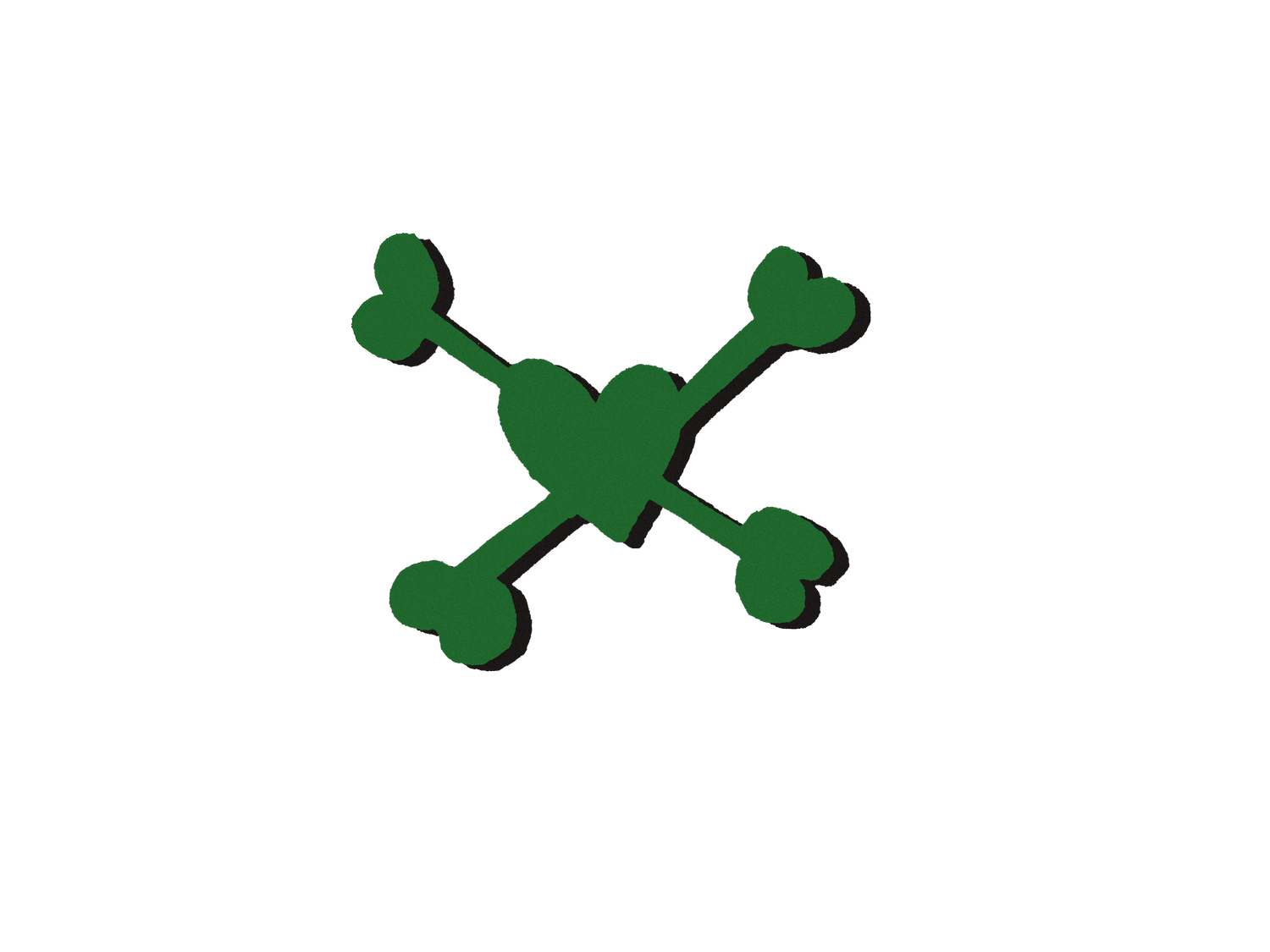INKED JOURNEY
A MODERN EXPERIENCE THROUGH THAILAND’S TRADITIONS
We often tend to underestimate the value of curiosity. We take pleasure in wandering through different spaces and merely scratching the surface of our surroundings. I firmly believe that curiosity is a gift, and when wielded wisely, it can reveal entirely new perspectives on what we thought we knew so well. I experienced this transformation while exploring South Asia. At that time, I was planning to go there to document traditional Thai tattoos and was interested in learning more about the ethnic groups in the region. I had doubts about Thailand, suspecting it had little more to offer than parties and intoxicated tourists. However, during my time there, I quickly became involved with meeting important characters of a tradition I never knew I would be probably the last to document. Suddenly, my perception became more refined, and things increasingly appeared sophisticated as I paid closer attention to the nuances of my surroundings. I began to spend time documenting the different traditions around me and the people who were part of them. It became clear to me that glimpses of historical and poetic moments were all around, waiting to be discovered by those who engaged with them attentively and sensitively.
This project delicately offers an omniscient and intimate view of Thailand's cultural heritage, traditions, and street scenes, capturing the poetic essence of its time.

Ban Nang Tao village, Lazy Man Coffee in the Pgak’yau Karen community, Thaïland, 2023. Ta Kra, Swea's youngest son, is almost 2 years old and is already joining his family in their daily communal farming tasks. I don't think I've ever seen a baby smile and interact with his environment so much.
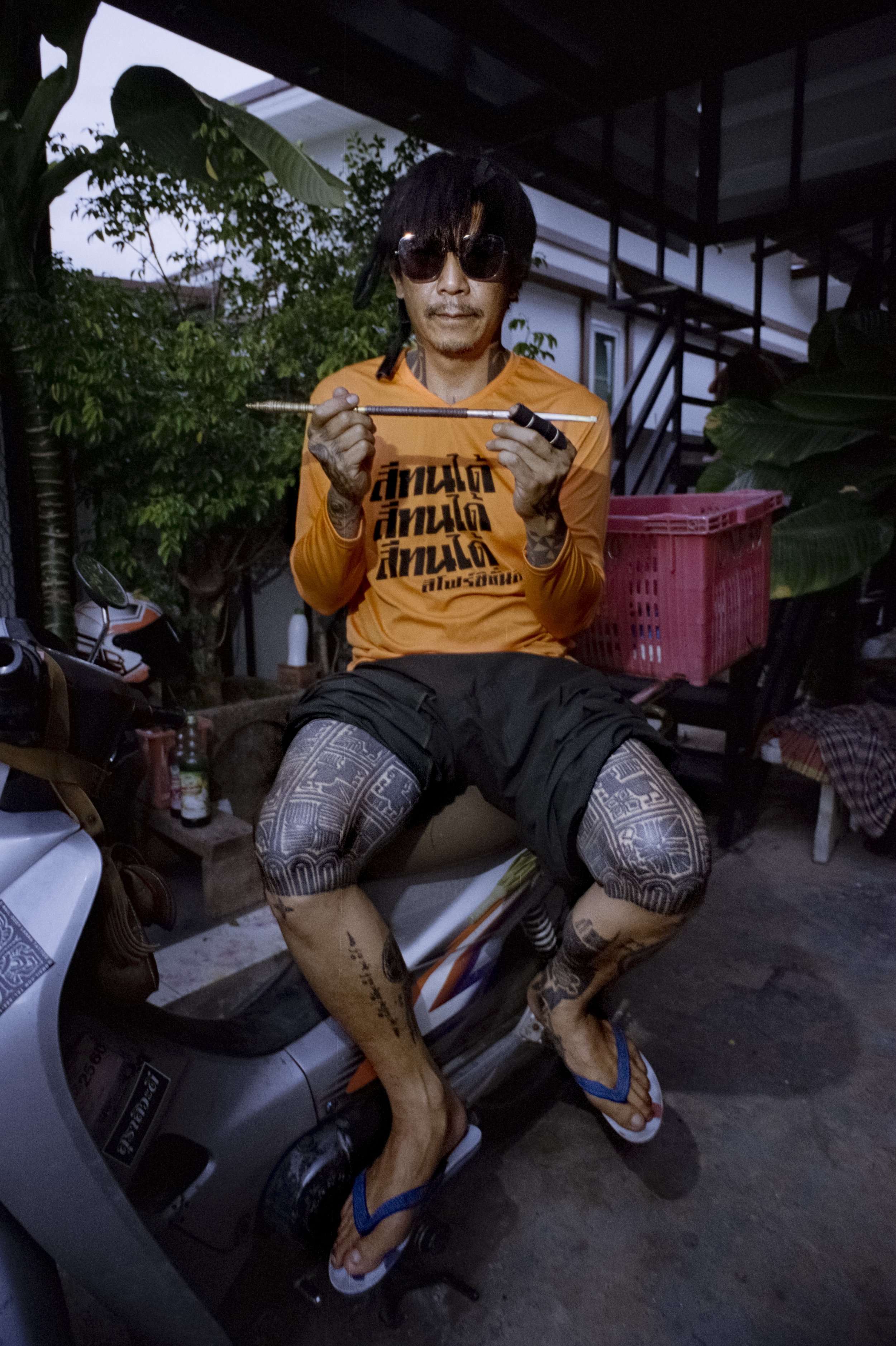
Chiang Mai Region, Oddy’s studio, Thailand, 2023. To understand the origins of the Lanna leg tattoo, you must look into the history of the Lanna Kingdom, which stands for Lan Na, an ancient kingdom founded around 1259 AD. This kingdom encompassed regions in northern Thailand, parts of present-day Myanmar (Burma), Laos, and some areas of southern China. According to research conveyed to me by Dr. Gun, research assistant at the École française d’Extrême-Orient in Chiang Mai, visible tattoo marks resembling those in the picture emerged around the late 19th century among the Lanna people. In this picture, you can see Oddy holding his traditional rod for tattooing.

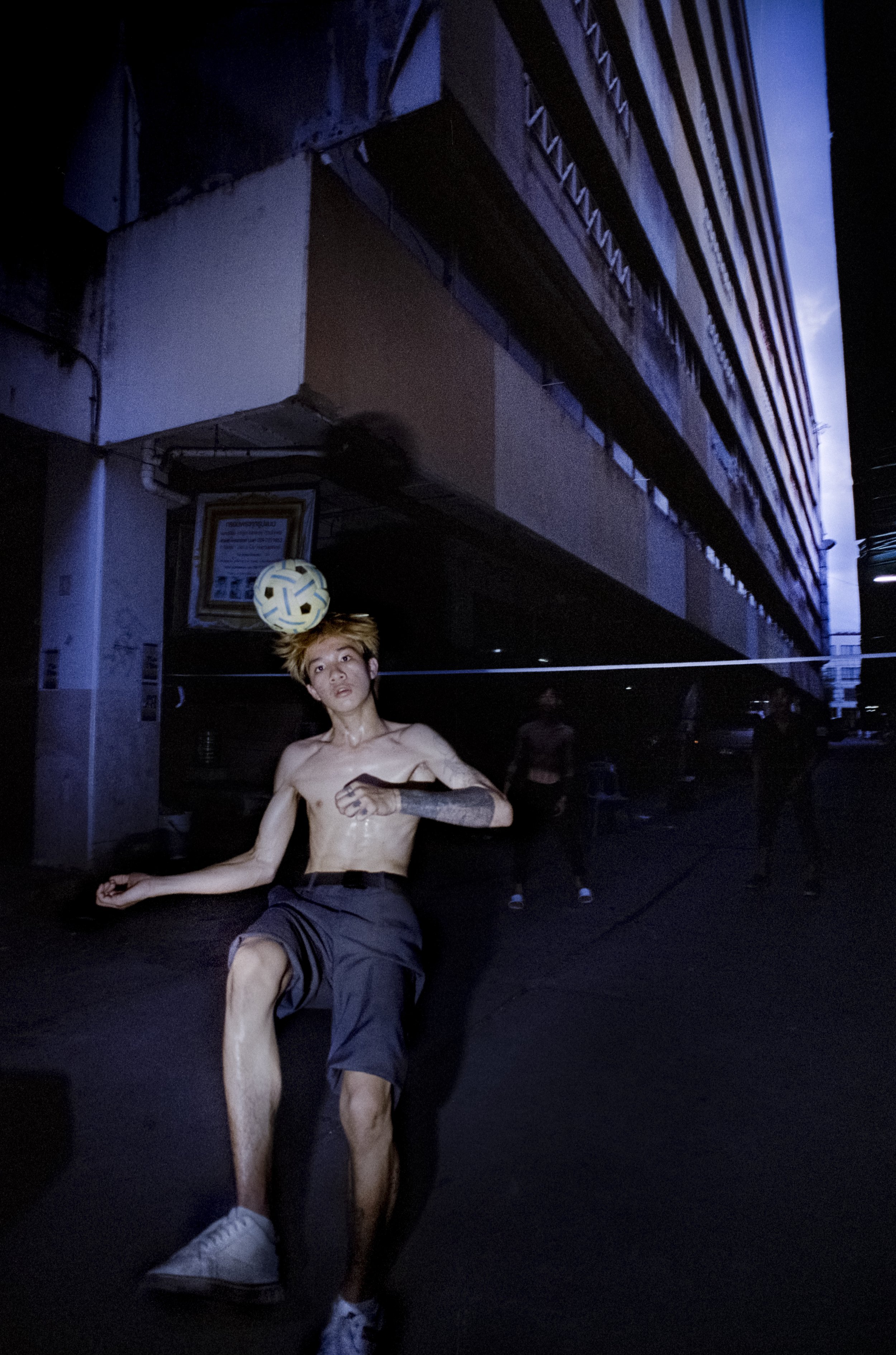
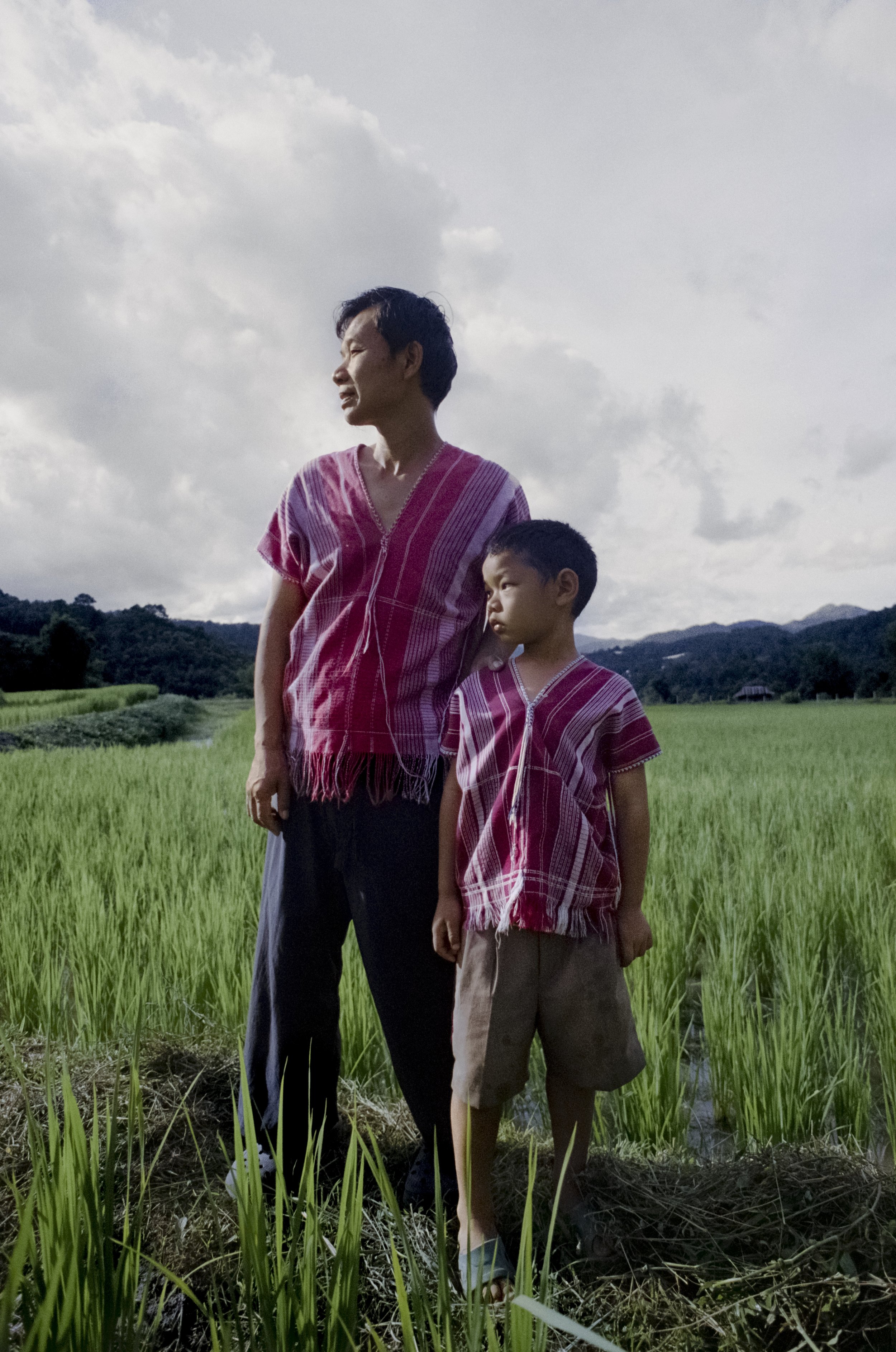
Ban Nang Tao village, Lazy Man Coffee in the Pgak’yau Karen community, Thaïland, 2023. Siwakorn Odochao, commonly known as "Swea," is the proud owner of Lazy Man Coffee, situated in Ban Nang Tao village within the Pgak’yau Karen community. As a devoted father to three young children, he stands out as a key figure in the contemporary activism of the Karen people. His father, Pati Joni, remains a renowned activist committed to advocating for the rights, structural integrity, and safeguarding of land crucial to the Karen community's heritage. Utilizing his land for cultivating coffee and rice, Swea embodies his native traditions, imparting wisdom to those eager to grasp the significance of a simple yet profound lifestyle that cherishes environmental stewardship and community unity. The Karen community has a poignant history, enduring oppression dating back to the 20th century at the hands of military groups. The constant struggle for their rights and recognition in the territory they rightfully belong to, situated between Myanmar and Thailand, underscores their unwavering resilience and strength. I recall a poignant moment when Swea recounted, "I remember during my primary school days being asked in an exam who was to blame for deforestation in Thailand, and shockingly, the 'correct answer' was the Karen people…" In the picture , Swea is seen with his second son on their land, teaching him knowledge on how to cultivate the land for the generations to come.
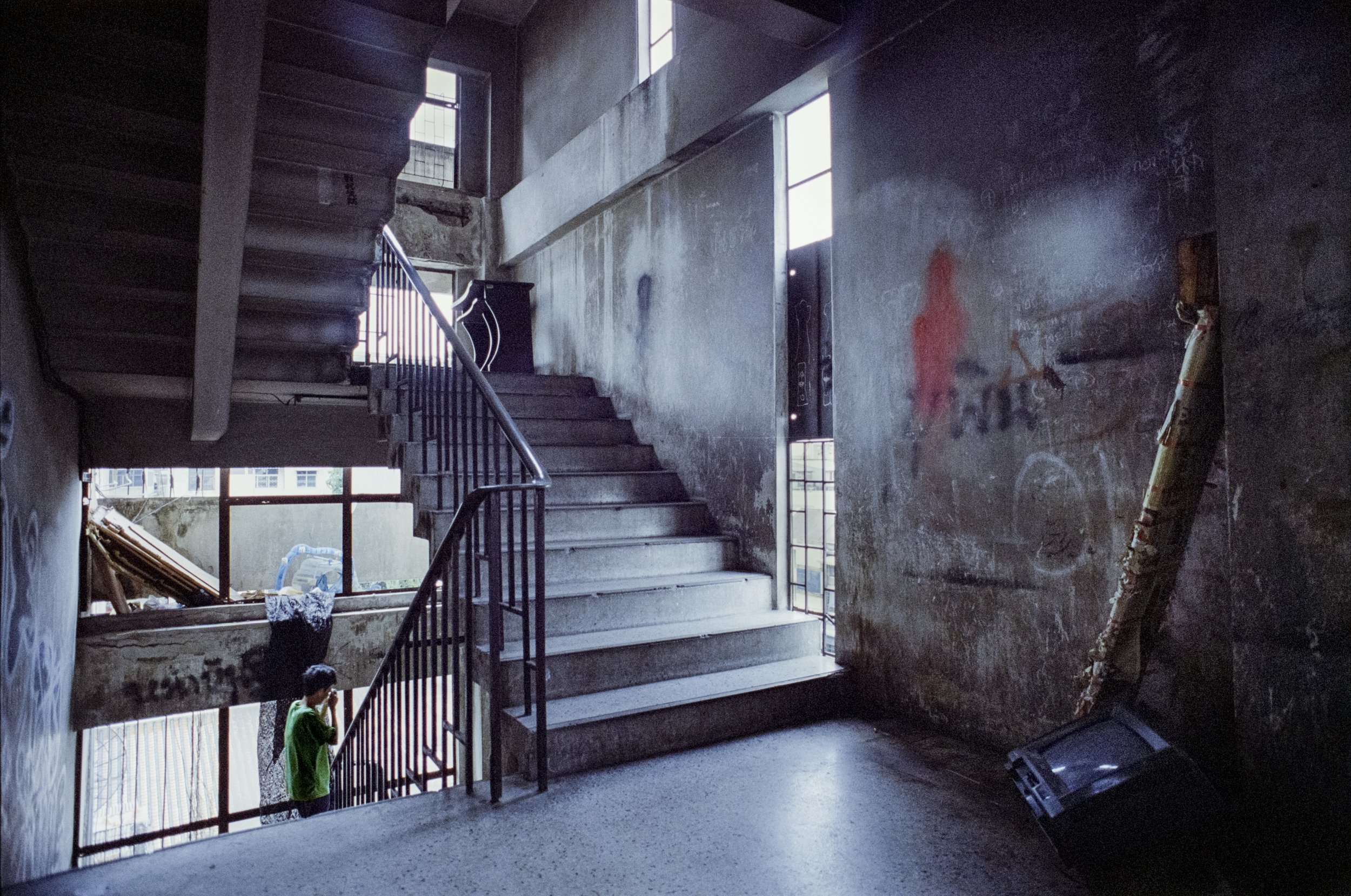

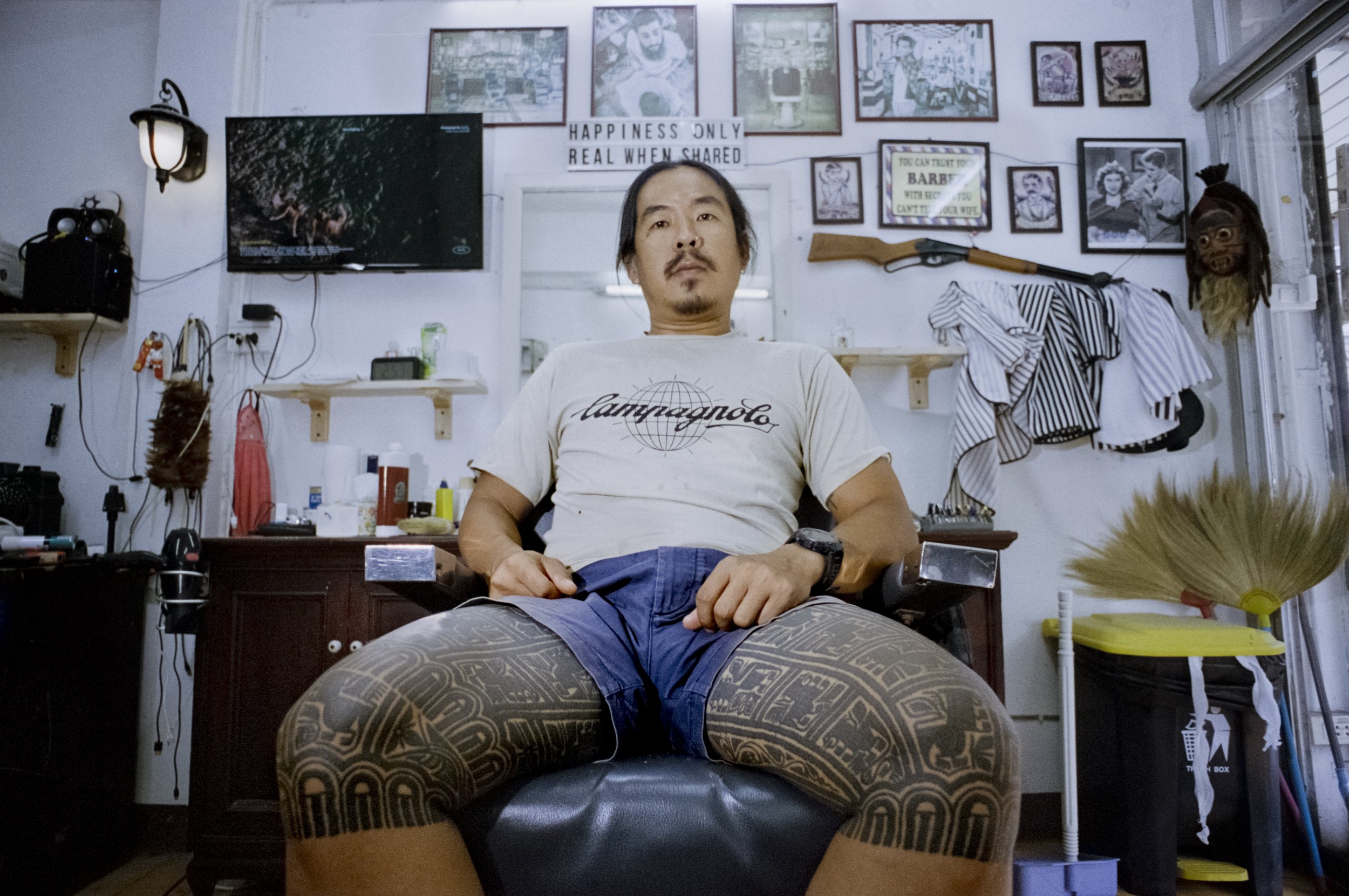
Chiang Mai city, Thaïland, 2023. Donut is a barber residing in the heart of a bustling neighborhood in the city of Chiang Mai. He's now part of a very small "family" that bears leg tattoos, a tradition typically found among the Karen villages in remote mountainous regions. As this culture gradually fades and is scarcely accessible, few individuals in larger cities have "Lanna" leg tattoos. In the photo, you can see a traditional design of the "Lanna leg tattoo." Typically, the tattoo comprises rows of squares from the lower knees down to below the navel, including the buttocks and pubic area. It features ancient animals, spirits, and symbols connected to nature, reflecting the strong animistic beliefs of the Karen and their lineage. It serves as a rite of passage and protection for a young man.
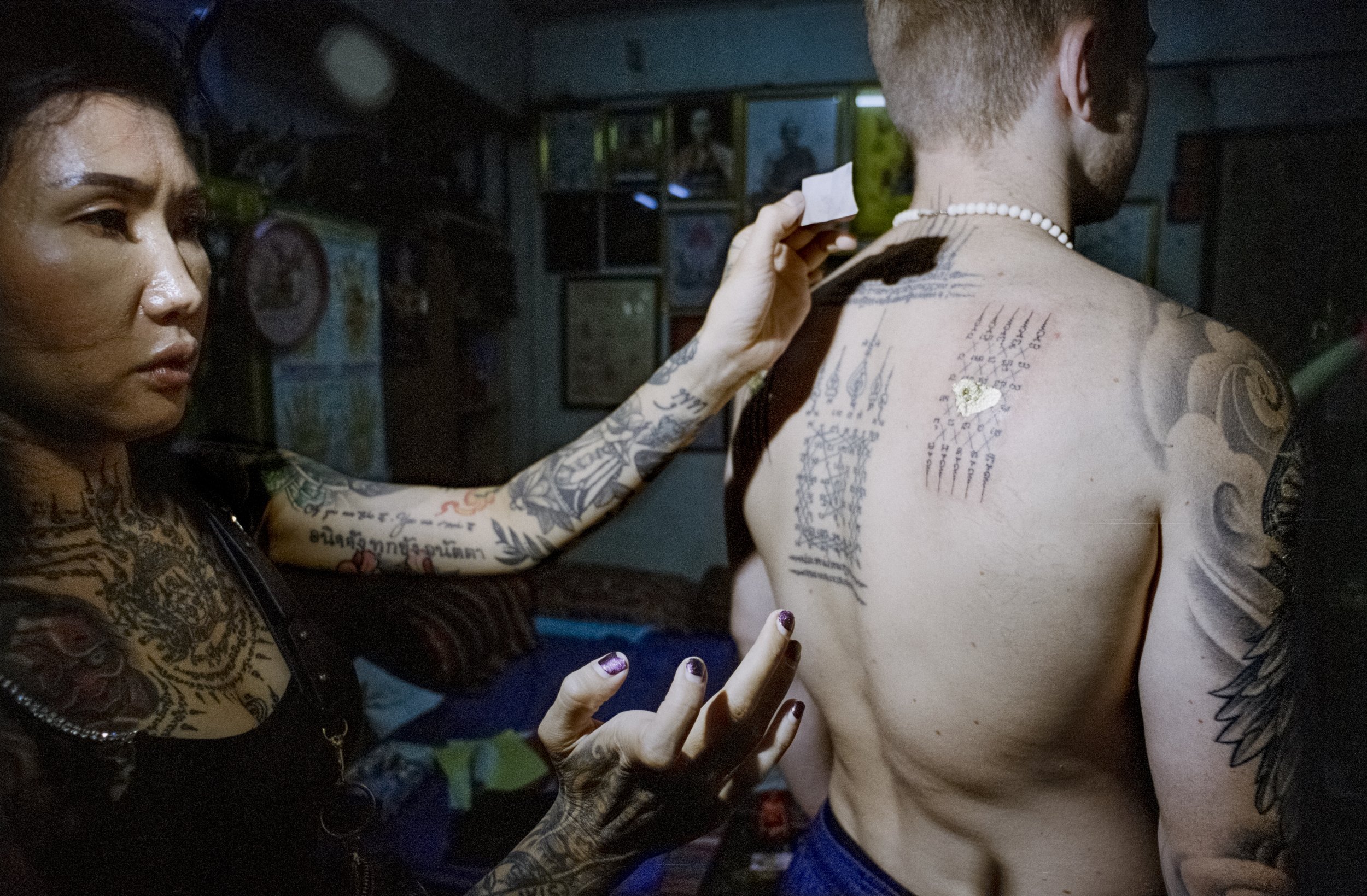
Chiang Mai city, Spiritual Sakyant Studio, Thaïland, 2023. Yok is the owner of a traditional Sak Yant tattoo studio in the city of Chiang Mai. Her studio stands out because, as a woman, tradition dictates that she cannot practice the craft of designing traditional tattoos. Through teachings received from highly respected monks in the region, she manages to navigate the rules while respecting traditions. Every day is a fight for her: educating and demystifying the myths surrounding this tradition within her community and among visitors. In the photo, she is seen placing a gold leaf on her client's fresh tattoo. According to tradition, this aims to bless the ceremony that will then be conducted by the master tattooist at her studio, "Ajarn Vee."
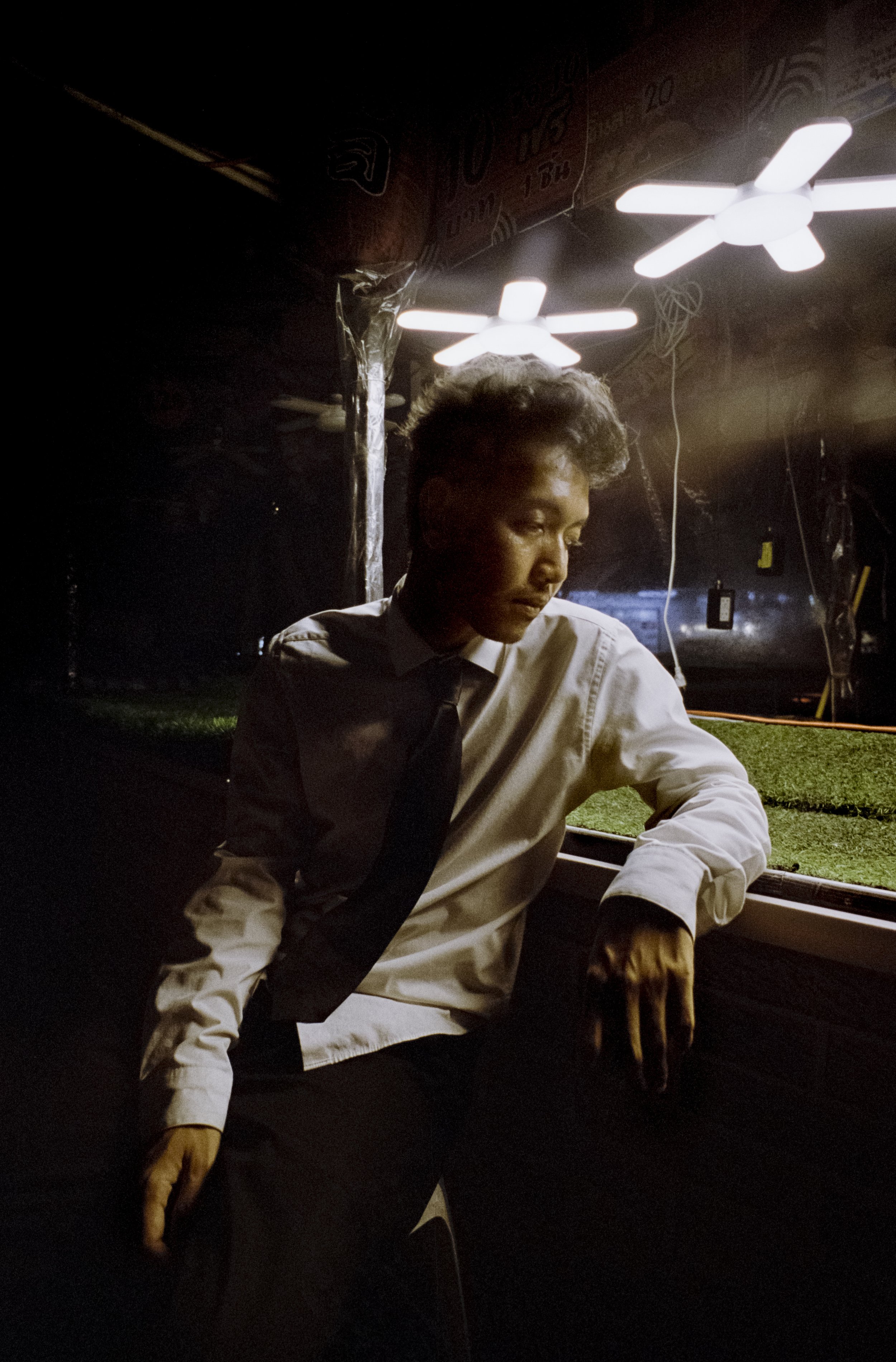
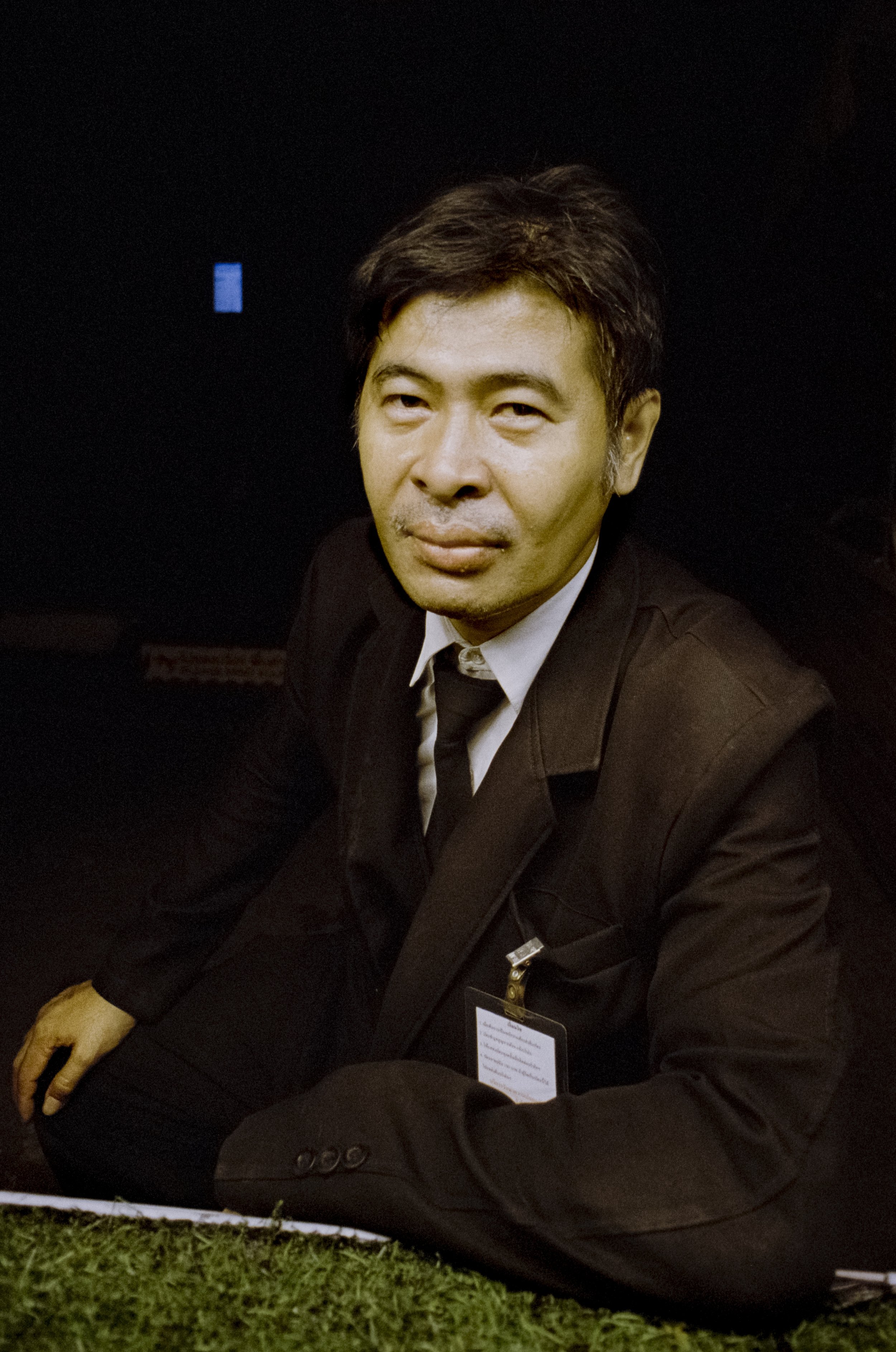
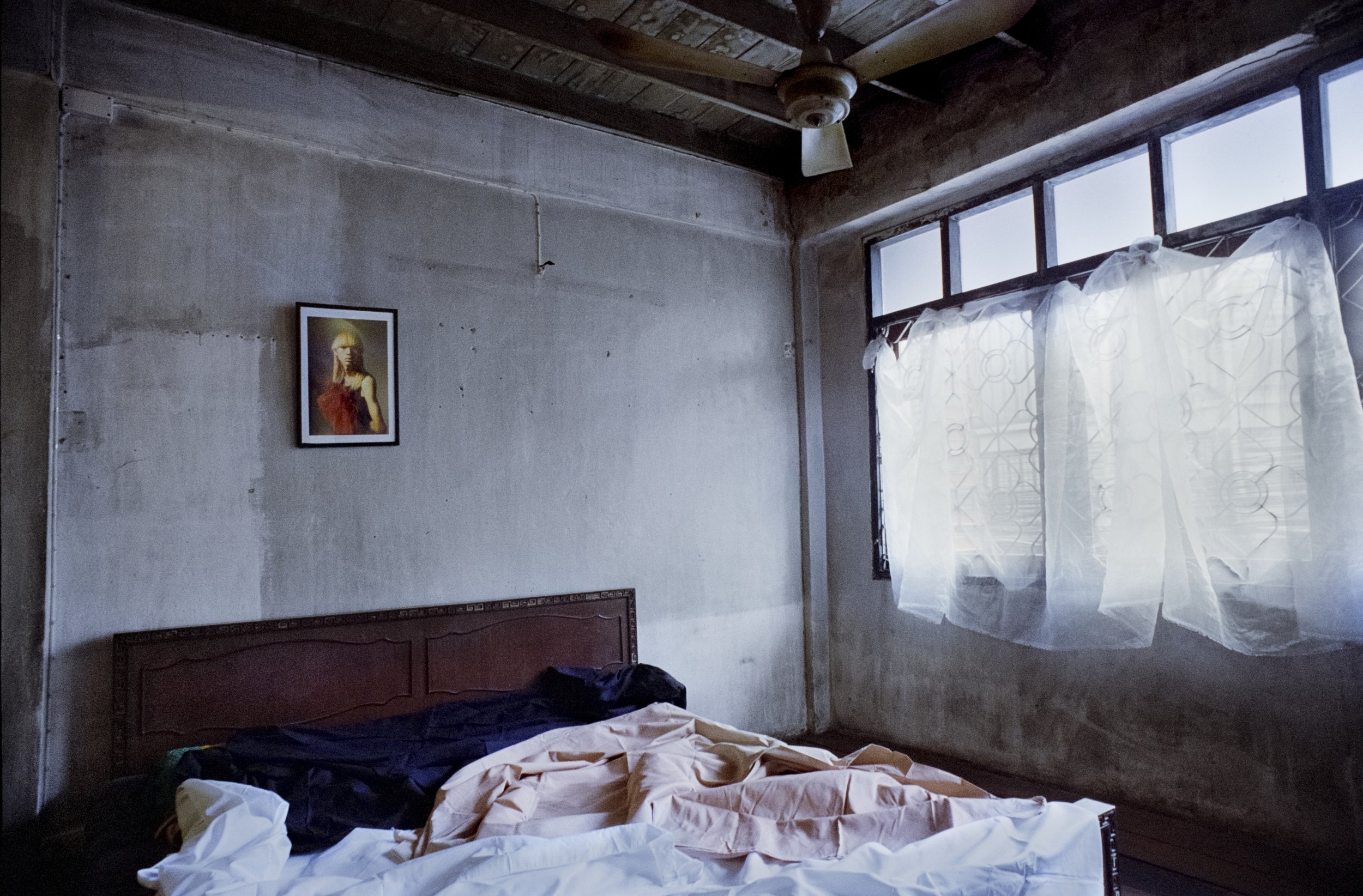
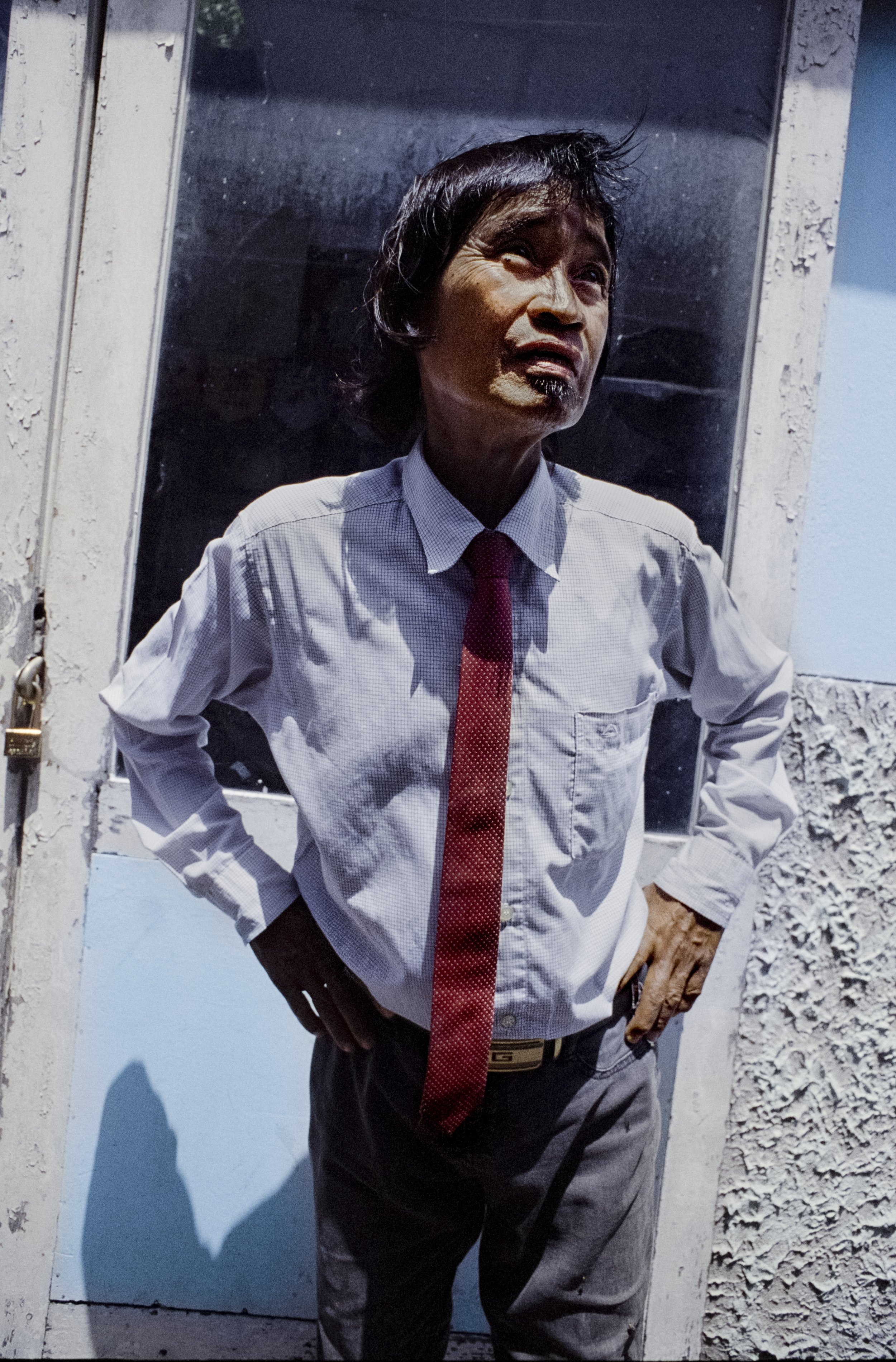
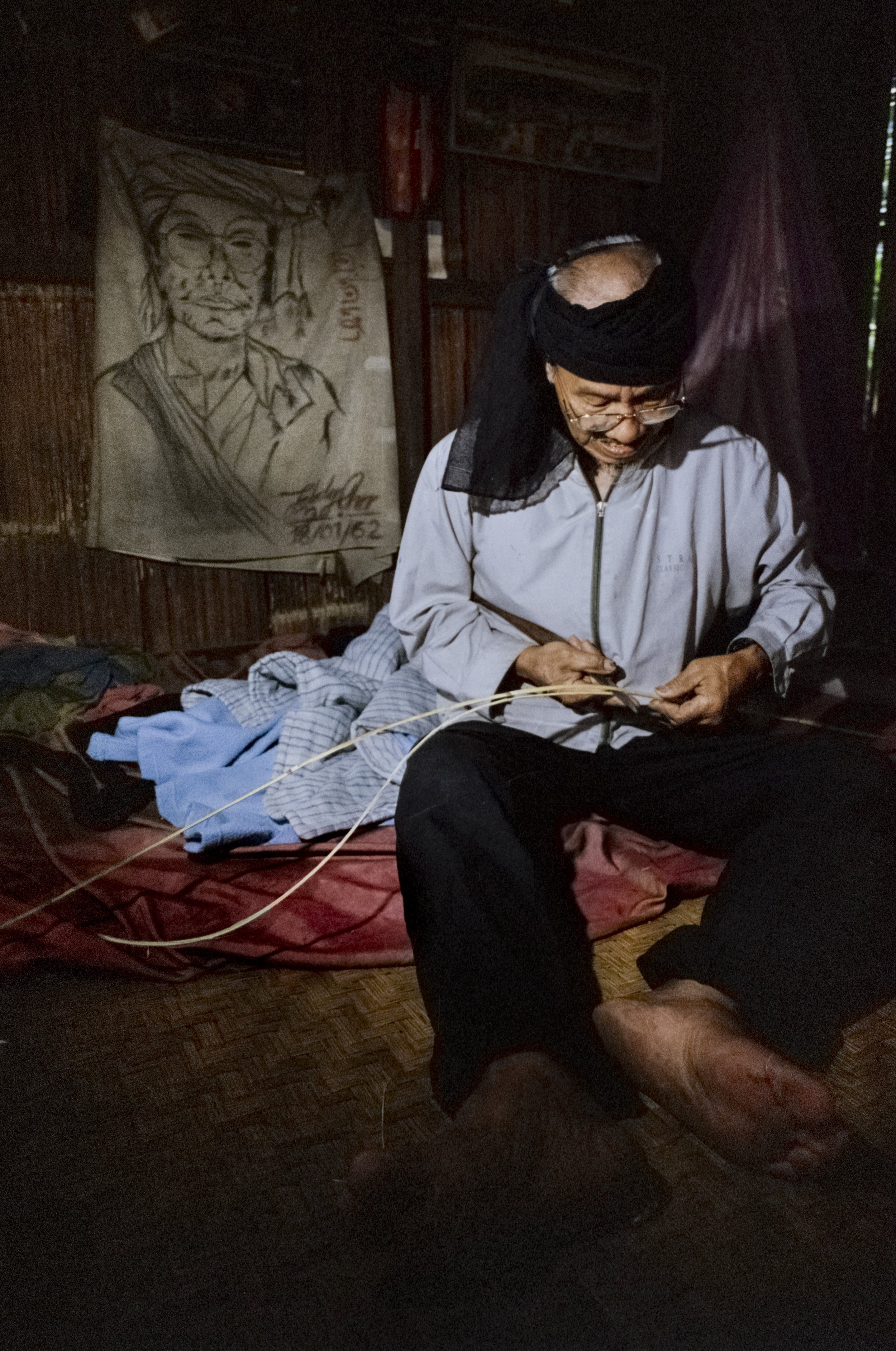
Ban Nang Tao village, Lazy Man Coffee in the Pgak’yau Karen community, Thaïland, 2023. Joni Odochao, also known as Pati Joni, hails from a small Karen village adjacent to the Pgak’yau Karen community. He settled there with his wife and three children, and they have stayed there ever since. Born in 1946, Joni had no formal education until the age of 17. Driven by his passion, charisma, leadership, and unwavering commitment to preserving and sharing his native heritage and way of life, he swiftly ascended to the role of headman in his village. Engaging actively in community forest management campaigns, he has been a guiding force, providing guidance to various non-governmental organizations, government agencies, and universities.throughout his life, Joni became a key figure, fighting to keep traditions alive and helping his community in essential ways. In the picture, you can see Joni crafting traditional bamboo baskets for a neighboring community friend.
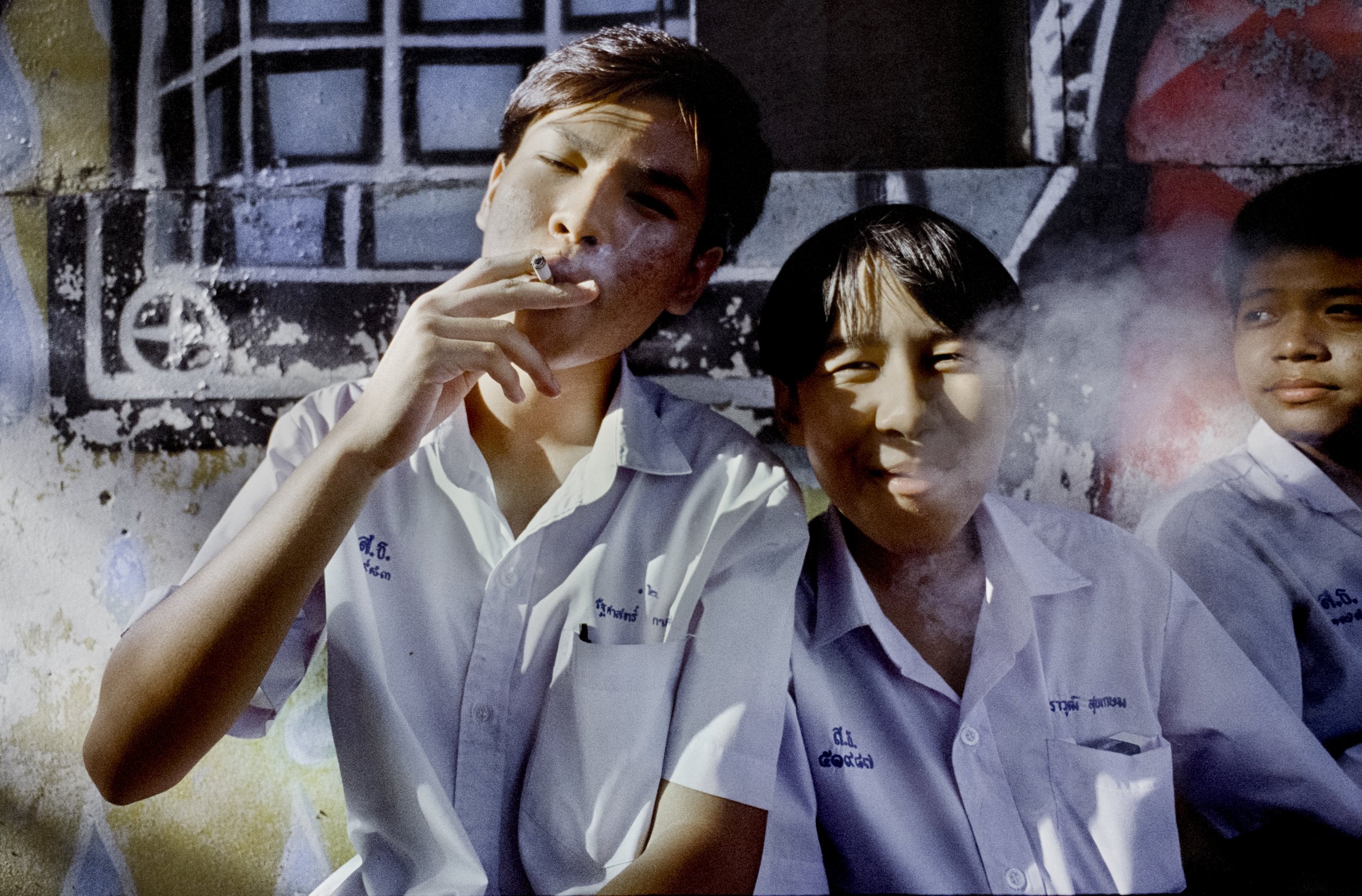

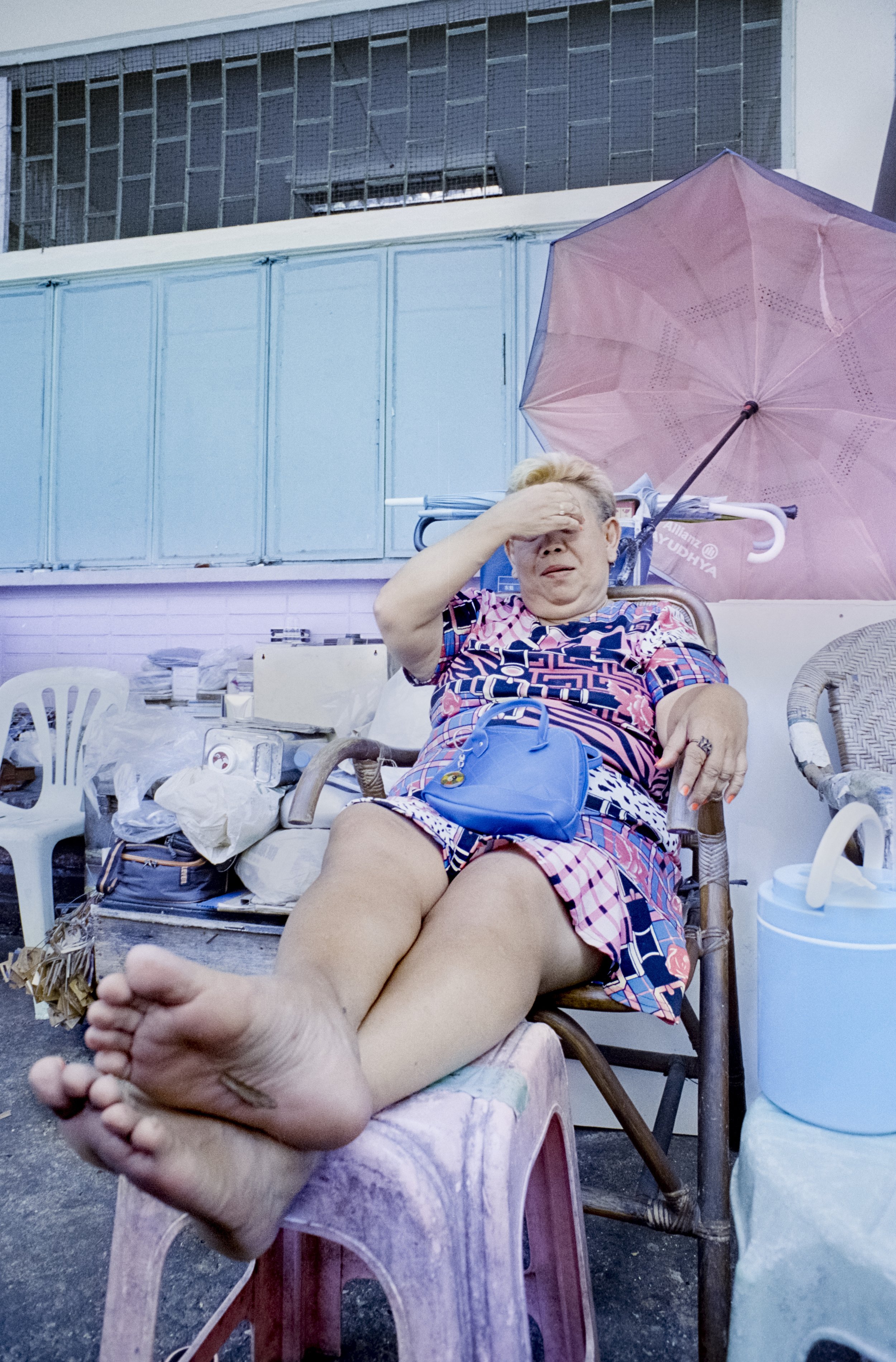
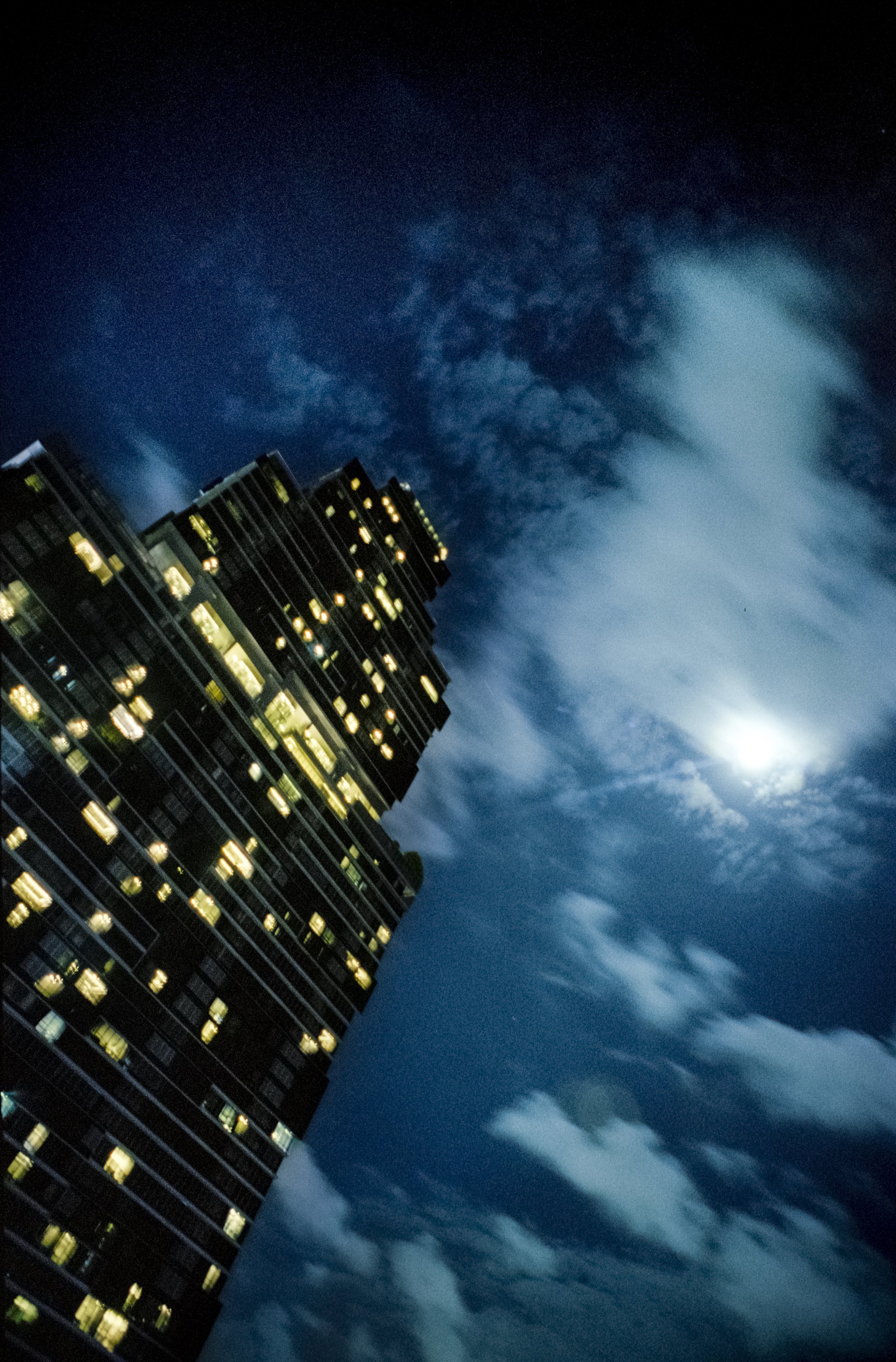
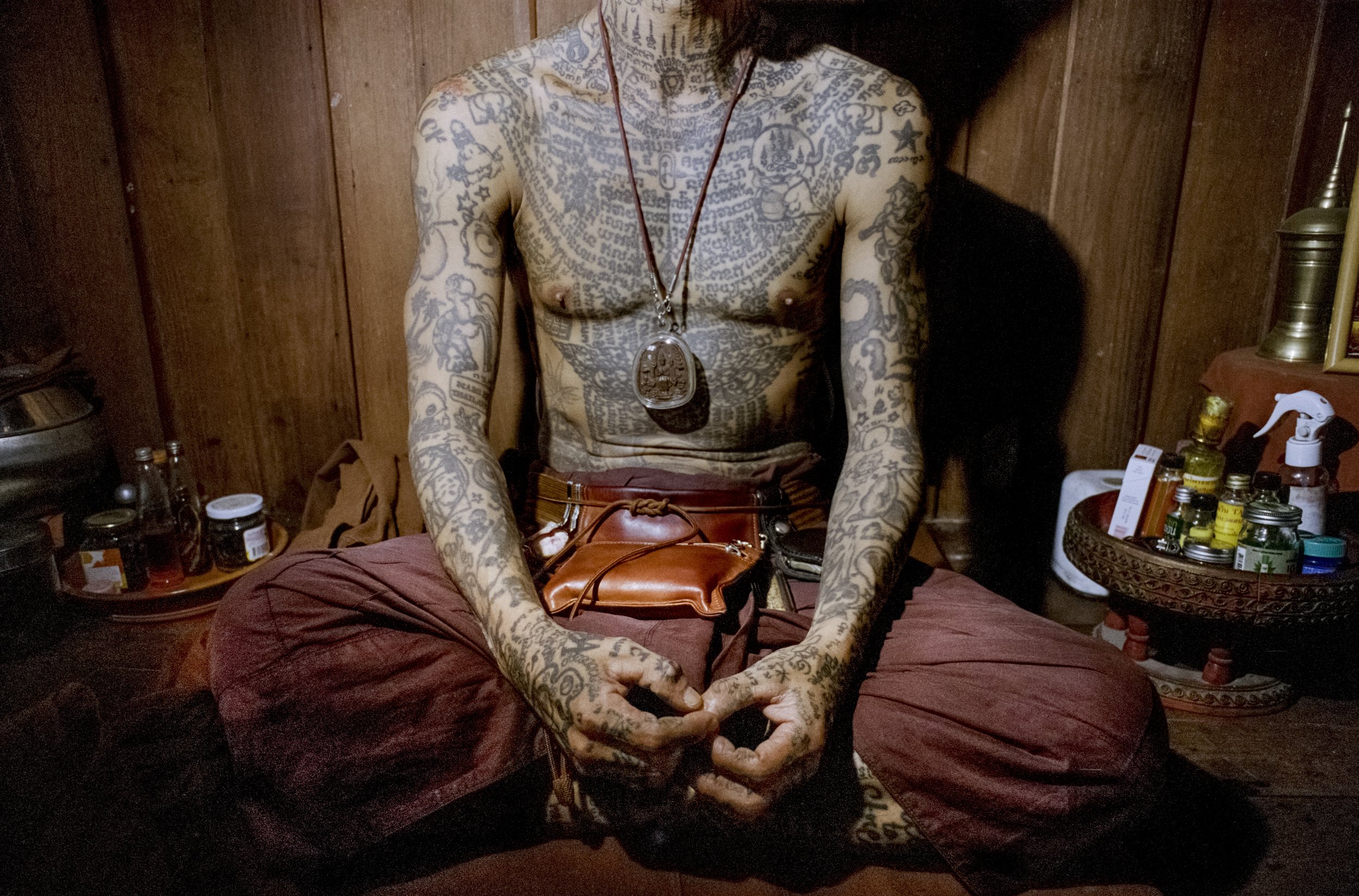
Chiang Mai Region, Thaïland, 2023. Golf is a former skateboarder who lived a life consumed by self-destructive behavior until his mid-thirties. For the past 5 years, he has devoted himself to becoming a Buddhist monk. In the photo, his body is adorned with Sak Yant protection symbols and ancient sacred scriptures known as Sanskrit.
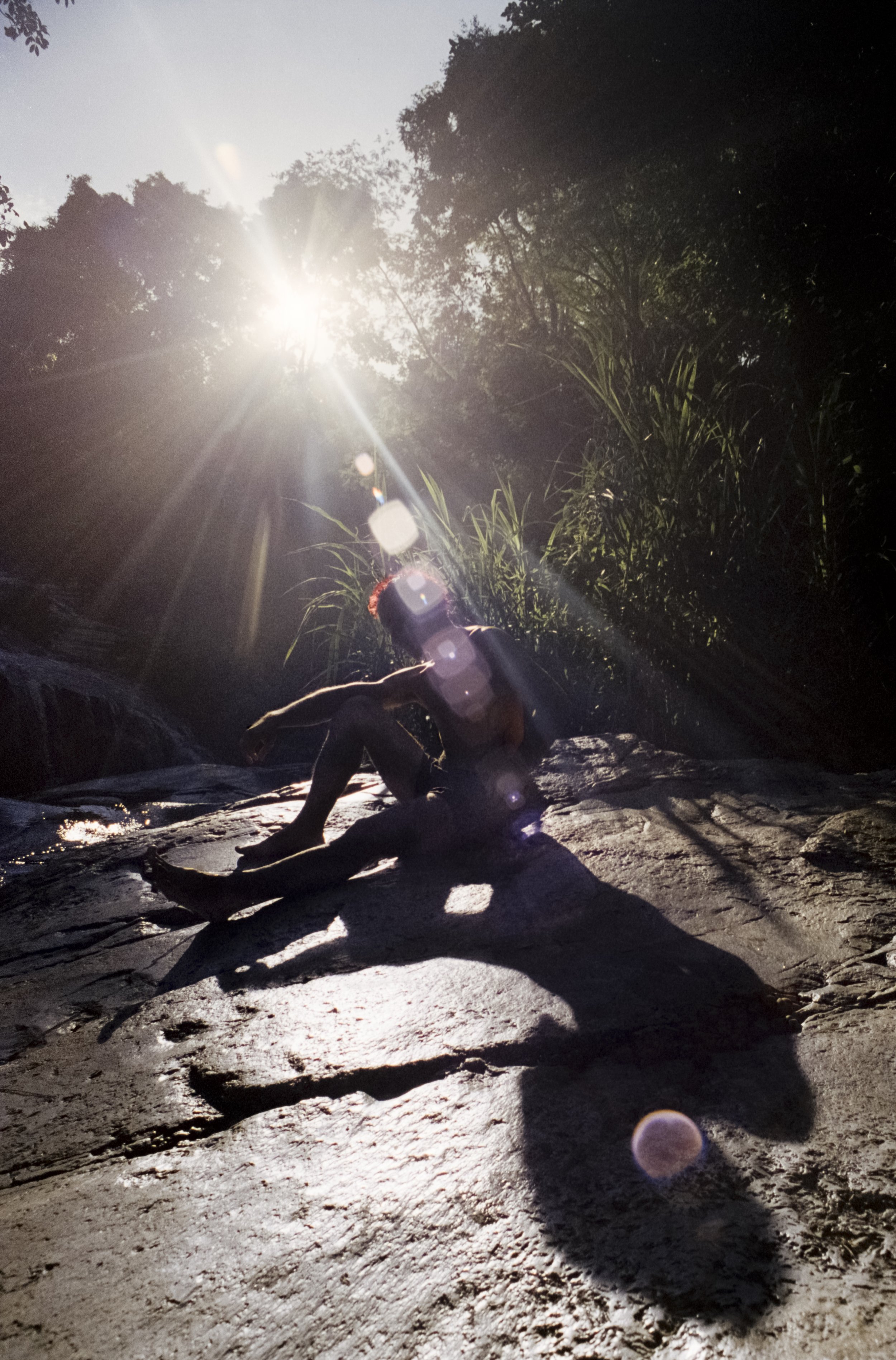

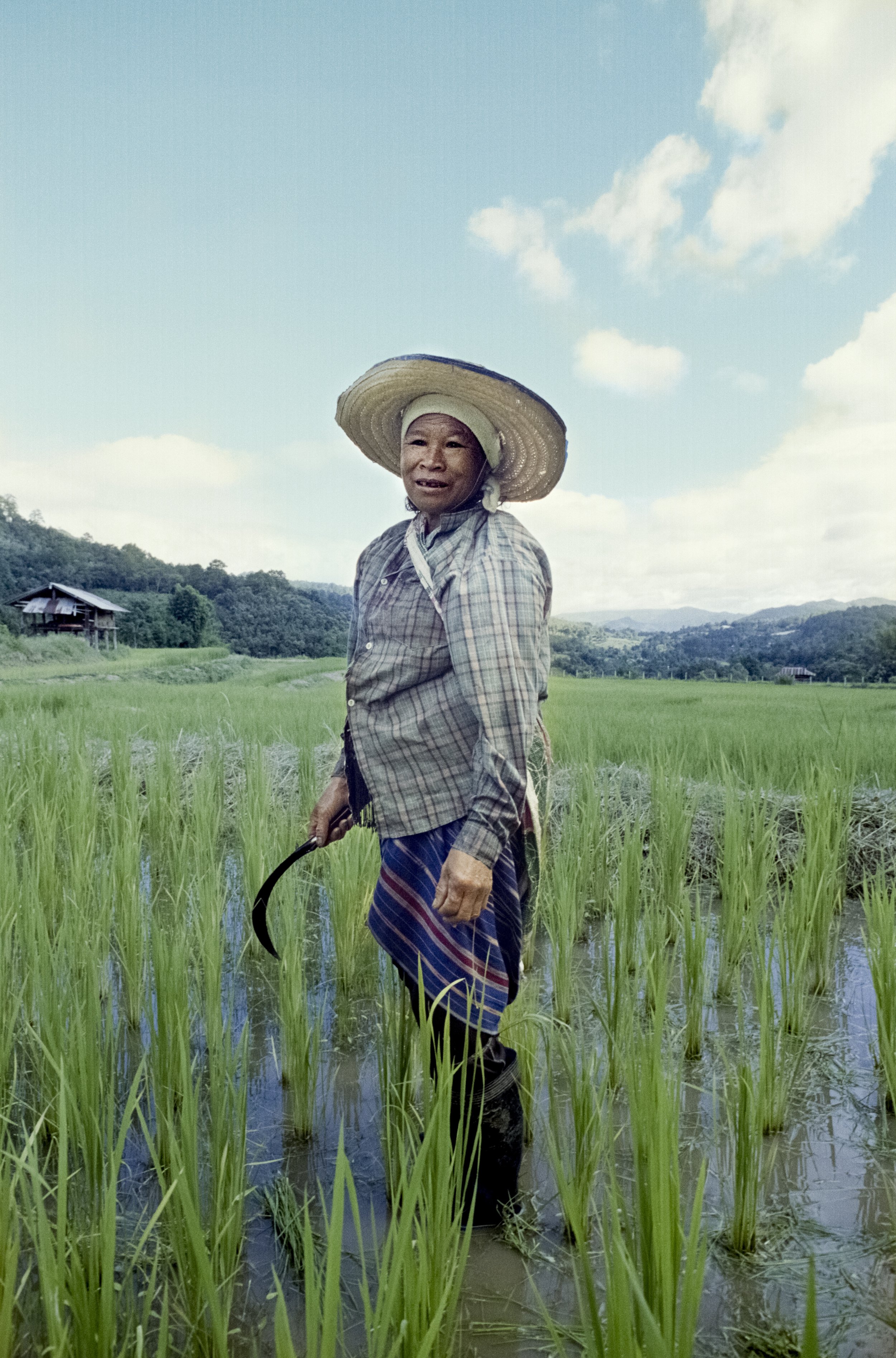
Ban Nang Tao village, Lazy Man Coffee in the Pgak’yau Karen community, Thaïland, 2023. A Karen woman, engaged in the traditional practice of rice harvesting, a significant source of sustenance for the Karen people. Engaging in farming activities, men, women, and older children contribute their labor in the fields or mountains. Their farming method, known as the rotational farming system, is distinct but often misunderstood by outsiders. This practice involves intensive cultivation of a specific plot of land while maintaining respect for the local ecosystem. After utilizing the land, they perform controlled burning, allowing the soil to rejuvenate naturally. They then shift to a different area and return to the initial land once it has regenerated. For the Karen community, this approach embodies a harmonious relationship with the land, working in tandem with its natural rhythms while honoring its resources."
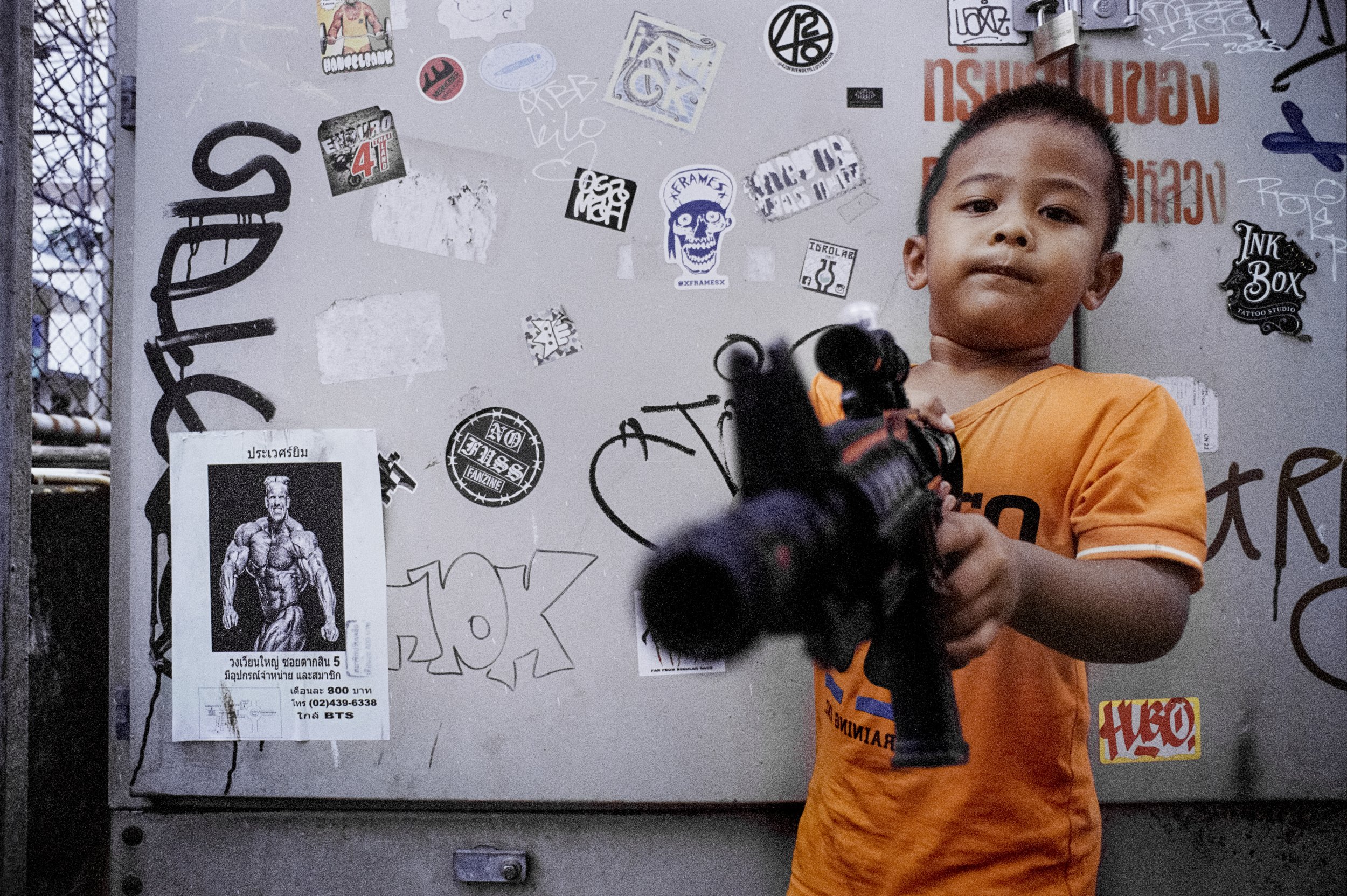



Tapijo Village, Karen village, mae tan sub district, Thaïland, 2023. Prayun lives in the same village as Ajarn Lada, the last master of the tradition. He currently works alongside him as an assistant, ensuring that the master has everything needed for the traditional process. Essentially, Prayun is responsible for preparing the materials and stretching the skin, facilitating the master's precise application of ink. In the picture, you can see him cleaning the traditional needle after I received my leg tattoo.



Chiang Mai Region, Oddy’s studio, Thaïland, 2023. Oddy is a central figure in the current "Lanna leg tattoo" culture. He is the last person to have learned from the final Karen master tattooist of this tradition in the world. After numerous visits to the native village and earning the trust and respect of the last master tattooist, Ajarn Lada, he was able to study this style and, in turn, practice it authentically. Unfortunately, Oddy is not part of the Karen ethnic group, and according to tradition, he cannot pass on the knowledge. This means that this culture, which has endured for hundreds of years, will fade away with Ajarn Lada. In the photo, Oddy is seen tattooing with a custom-made metal rod, inking a young Thai individual who wishes to carry on the tradition.


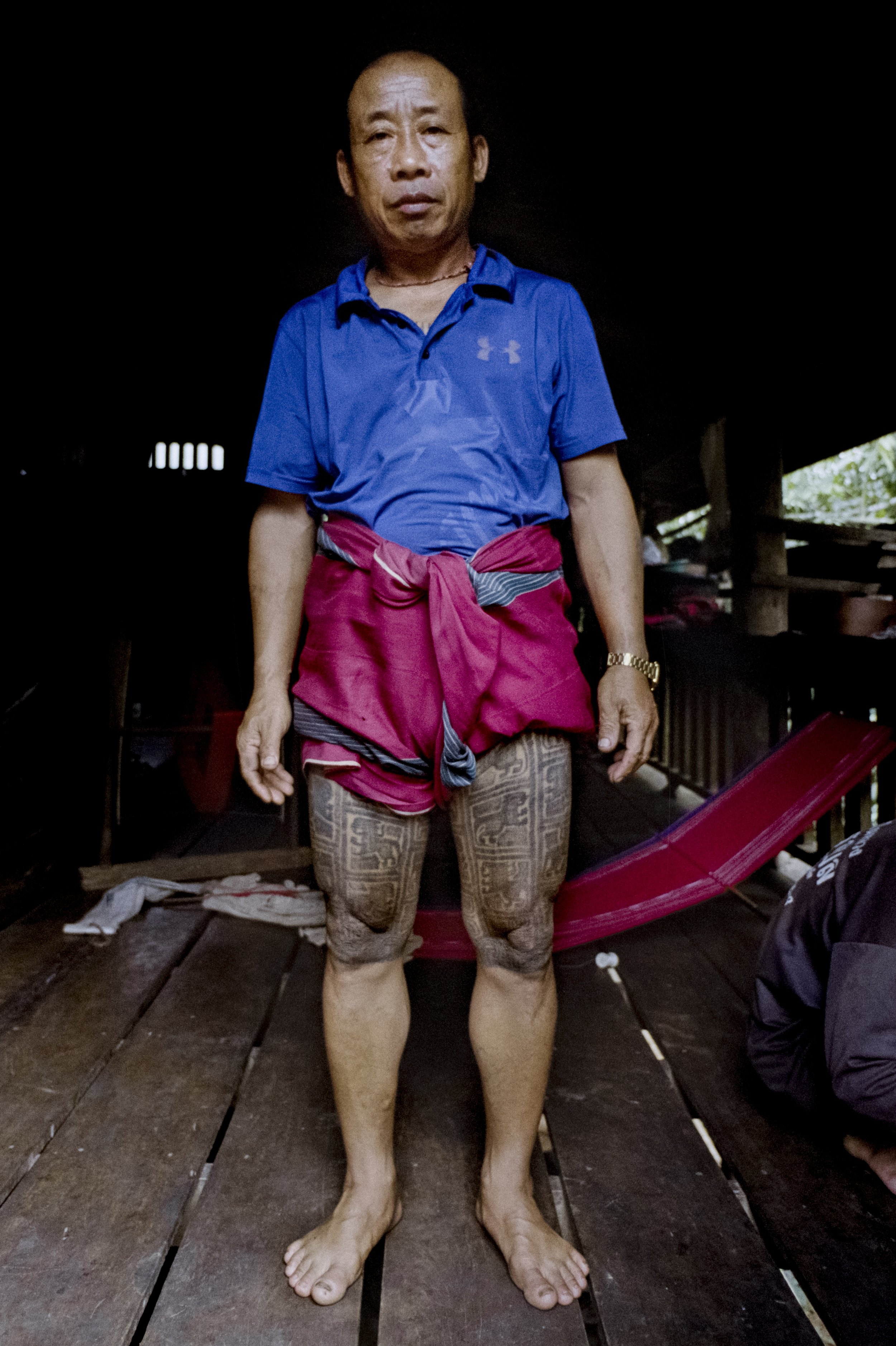
Tapijo Village, Mae Tan Sub district, Tha song Yang District, Tak Province, Thailand, 2023. Ajarn Lada is officially recognized as the last master practicing the Lanna leg tattoo globally. He resides with his wife and child in Tapijo Village, a small Karen community located approximately a two-hour journey deep into the jungle from Mae Sot, near the Burmese border. His journey to master this art began at a very young age while observing the techniques of the old masters. He was consistently fascinated by this craft, witnessing it on men in his village when ancient masters passed through. During those times, it was customary and pivotal for men to bear the Lanna leg tattoo. Young men eagerly sought to tattoo their legs whenever a master visited their village, aspiring to transition into manhood as per tradition. Understanding the rarity of such visits, they queued up, knowing they might not have another opportunity until the next master's arrival. This act aimed to gain the approval of the women they wished to marry in their village or neighboring areas, marking a significant step into their adult lives. The physical and mental endurance required for this process showcased their strength to the village. The symbols inked were crucial as they held strong beliefs in animism, embedding protective symbols within themselves. The tradition, known as "One leg, One day," almost turned into a competition among masters to swiftly complete the process due to the high demand for tattoos and the scarcity of active masters at that time. After nearly two months of effort, earning the community's respect and diligently studying the subject, I gained enough trust to visit and stay with them. Accompanied by my translator, Winnie, I spent three days living and eating with them. The agreement was that if I visited, I needed to ink my legs according to tradition. I was excited about it, especially since Ajarn Lada might stop this practice next year. It was an honor to be part of a tradition on the brink of extinction that originated around the 19th century, persisted till today, and was usually closed to foreigners. The number of foreigners historically accepted for this tradition is scarce, and being among them is beyond belief. I completed one leg, intending to return for the other as per my promise. I hold immense respect for these people. Despite having experienced intense and precarious situations while tattooing before, this was the most physically and mentally painful experience in my life. The process took a relentless 12 hours without breaks. I strongly believe that their unwavering belief in this tradition helps overcome such fears. Ajarn Lada adhered to the tradition of , " one leg, one day" completing it at the age of 13, an early age by the standards of that time. Though he pursued farming like others in his community, Ajarn Lada always felt a calling towards this art. I made a commitment to return and complete my other leg, and I always keep my promises.
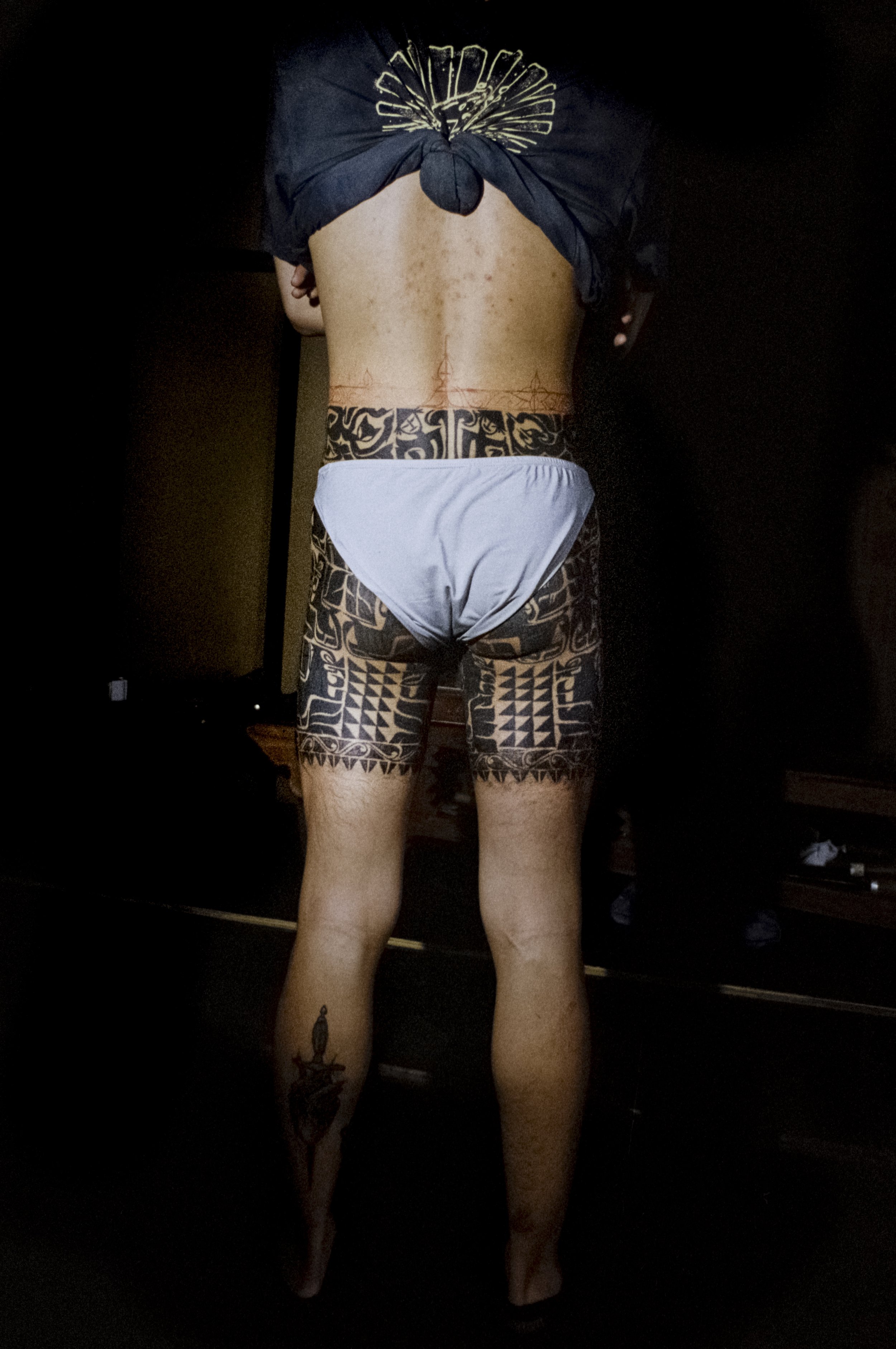
Chiang Mai Region, Oddy’s studio, Thaïland, 2023. In this image, we see a young Thai man named Jom, a client of Oddy, who has just completed a session to add two new stripes to his Lanna leg tattoo tradition. This act possibly signifies his commitment to continuing a tradition passed down by his elders. The shorter leg tattoo is unconventional, deviating from the traditional method that typically extends from the knees to the belly. This divergence in the Lanna tattooing tradition occasionally arises from ancestral influence. There isn't a specific reason behind this trend; rather, it seems to be a manner adopted by certain individuals that becomes fashionable. On the back of his legs, there's an unusual symbol resembling a triangle. It's been explained that these symbols are likely representations of duck's teeth, believed to protect against animal attacks. Jom might have requested this particular tattoo because one of his ancestors had it done, and in his village, such protection was deemed necessary.
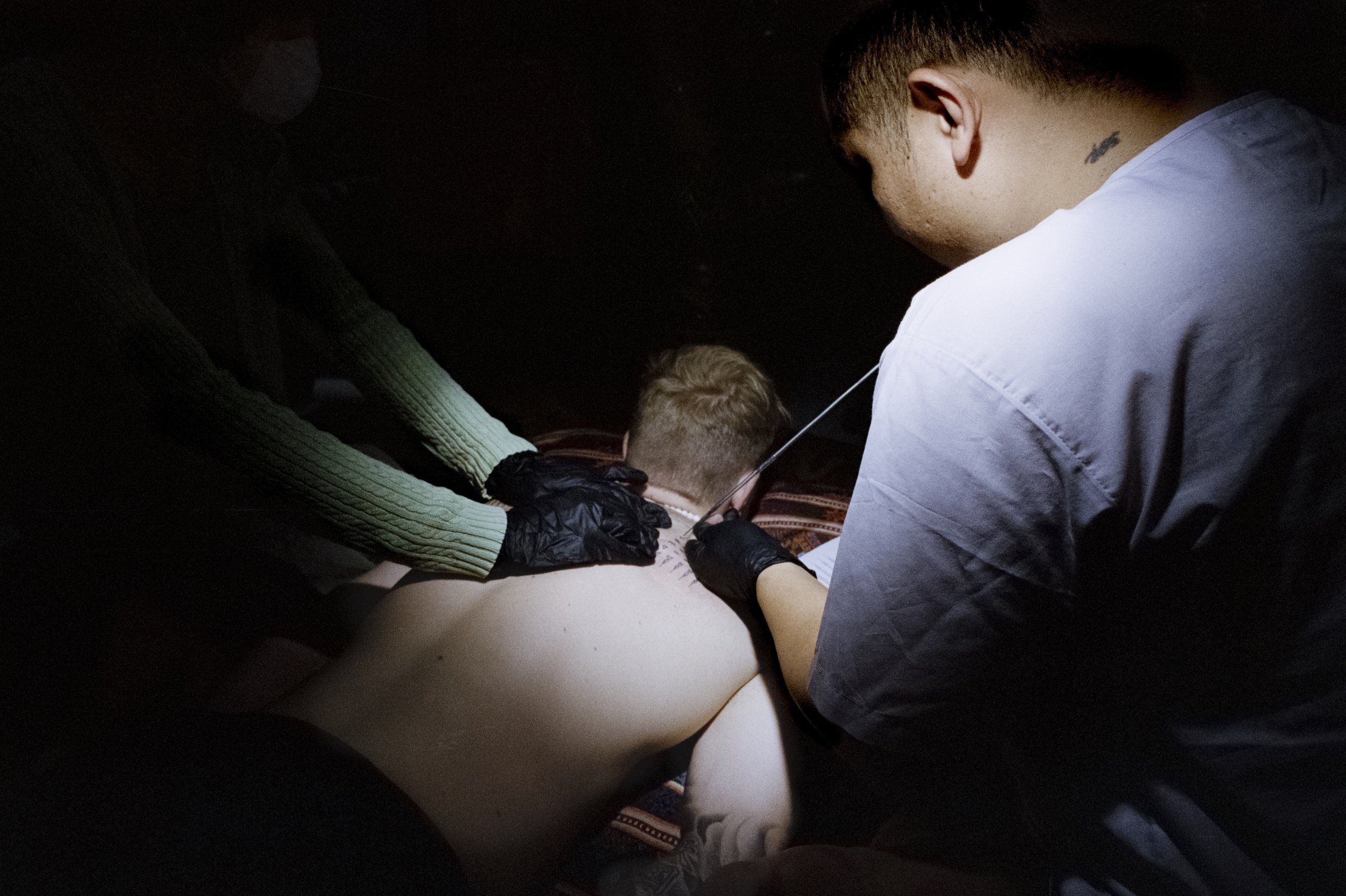
Chiang Mai city, Spiritual Sakyant Studio, Thaïland, 2023. Ajarn Vee, an "ajarn," works at Yok's studio but resides a few miles away in a temple with monks. Every day, he commutes for an hour to tattoo magical Sak Yant designs for customers—foreigners, Thai individuals, and more. He dedicates around 10 to 12 hours daily to this craft. An "ajarn" in the Sak Yant tattoo culture is someone who undergoes extensive training under a certified master. This training involves studying various elements such as ancient knowledge, symbols, scripts, Buddhism, Animism, sacred geometry, and even black and white magic, all intertwined into the creation and blessing of these tattoos. To become a Sak Yant Master, one must study under an existing Master. It's a lengthy process crucial for someone to be recognized as a master. Some tattoo studios claiming to offer Sak Yant tattoos may lack this essential training, which doesn't respect the tradition. Believers in magic might face issues if incorrect spells are inscribed during the ceremony. Essentially, these tattoos are for protection and strength. If they aren't done traditionally and properly, they may lose their intended purpose.
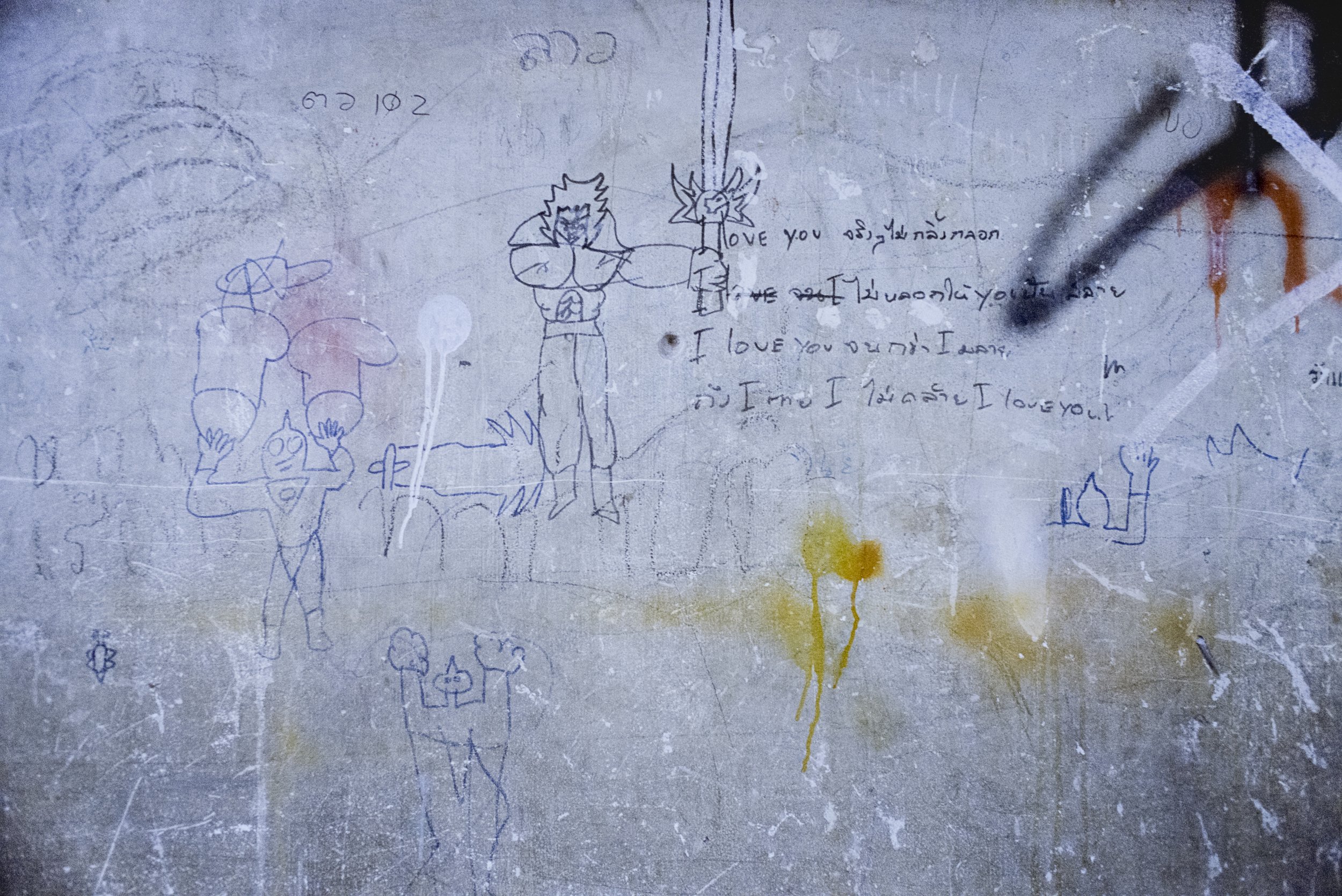
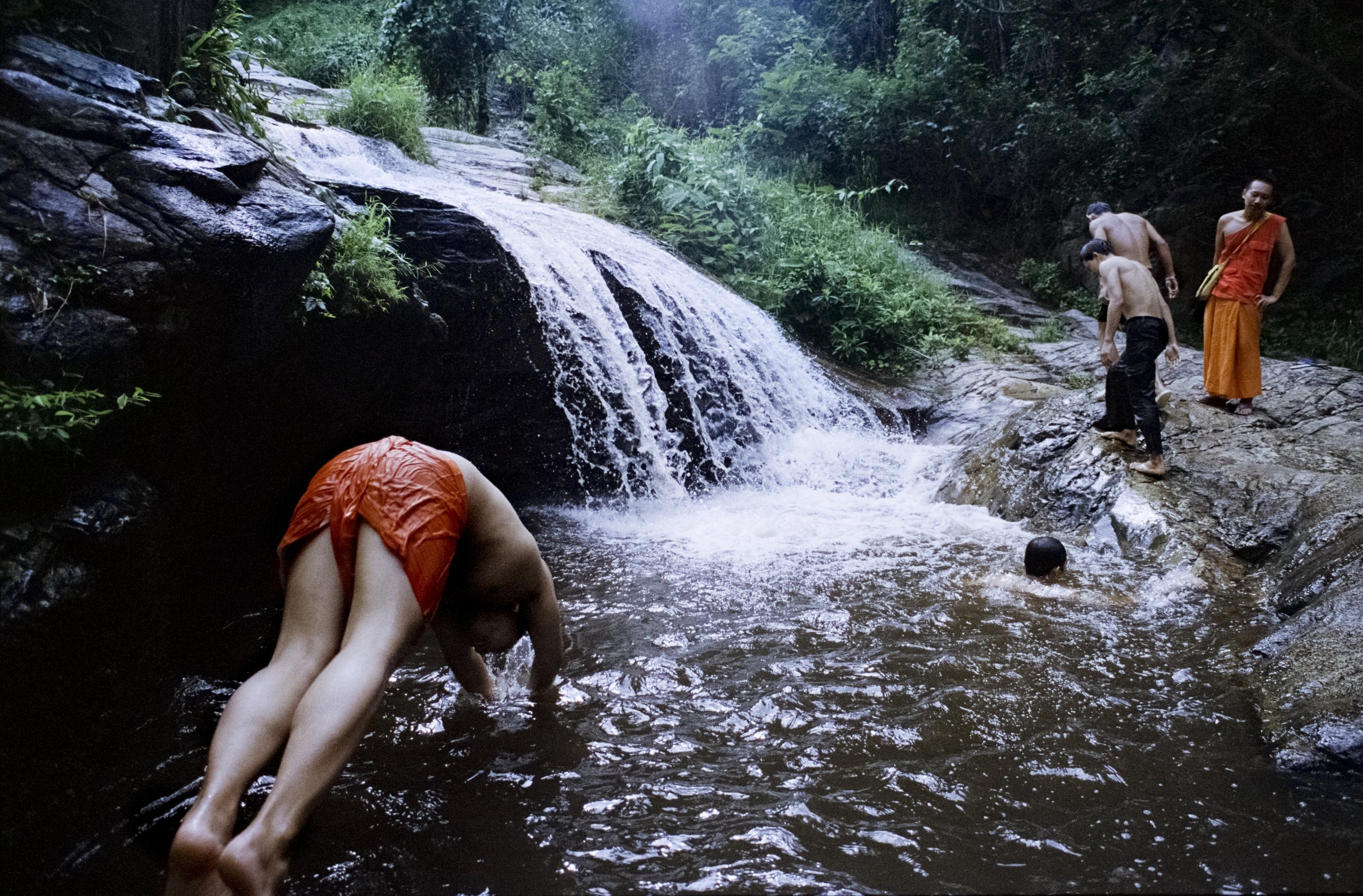
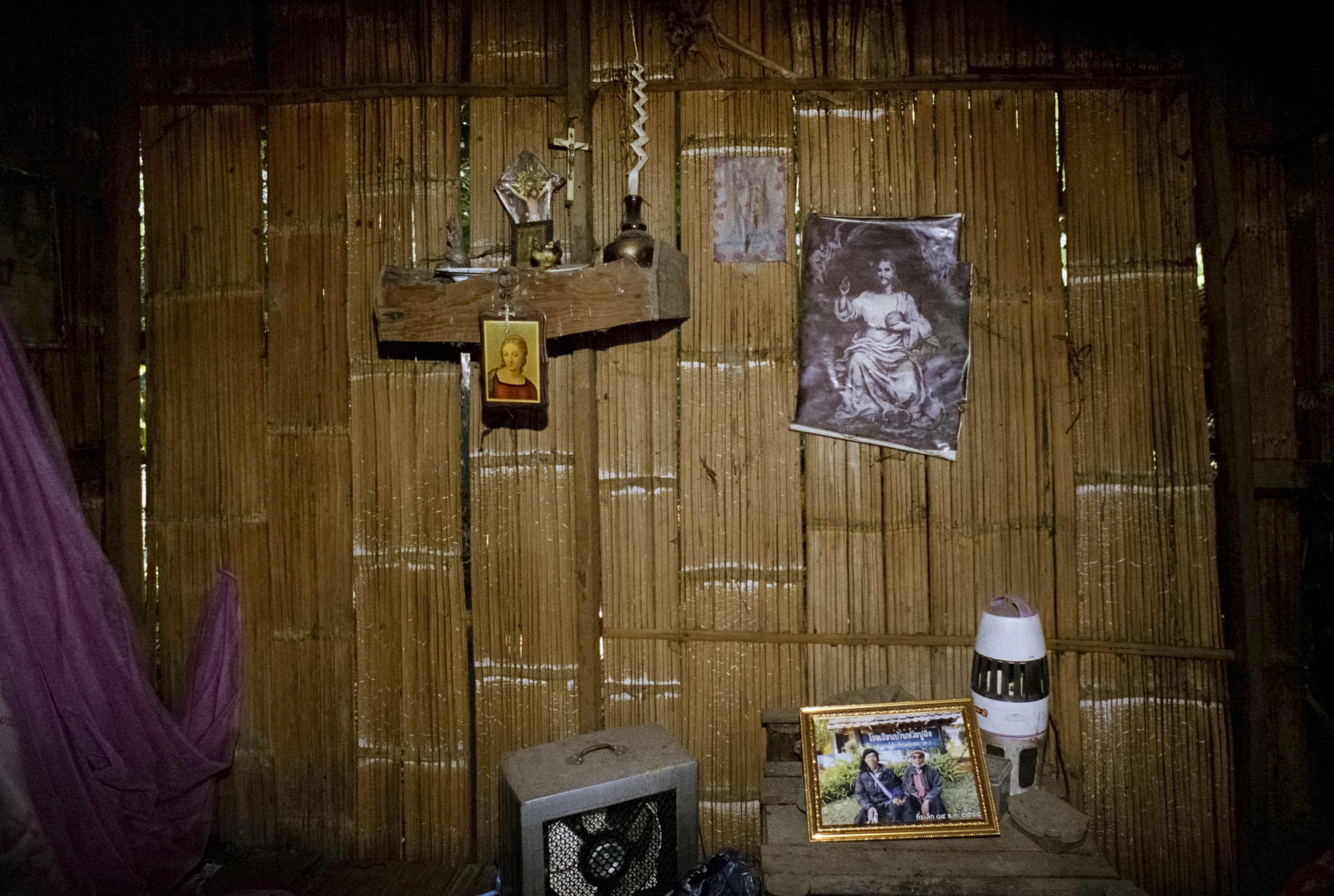
Nong Tao, Karen village, Chiang Mai region, Thaïland, 2023. In Joni Odochao, also known as Paty Joni's private room, you can observe his establishment adorned with objects linked to Christianity. Contrary to common beliefs, the Karen people vary in their religious practices depending on their regions and communities. While some follow Christian beliefs, others adhere to Buddhism, and some maintain indigenous or animistic traditions. The religious landscape within the Karen community displays diversity, with individuals having distinct religious affiliations and practices influenced by personal beliefs, family customs, and regional factors.
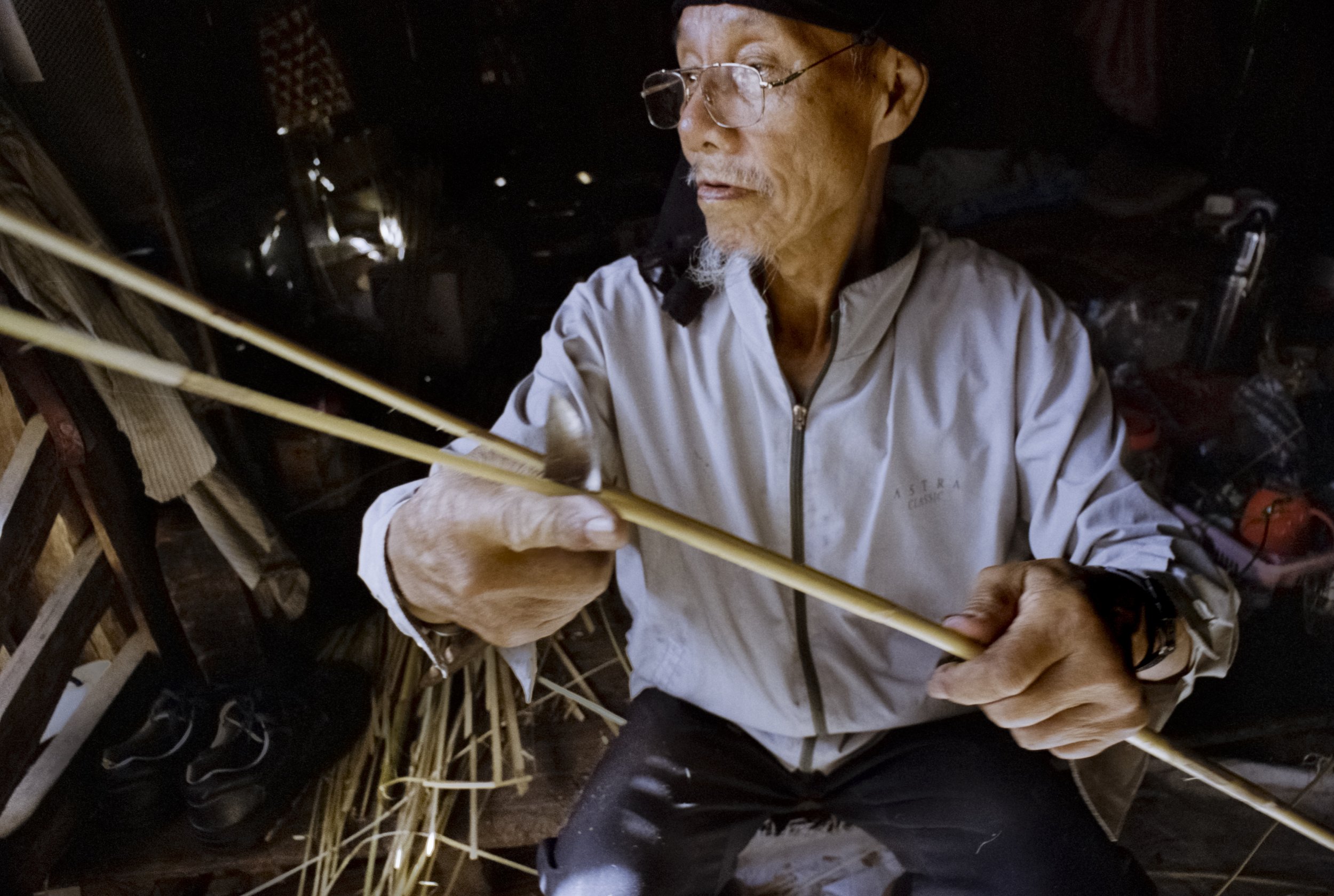

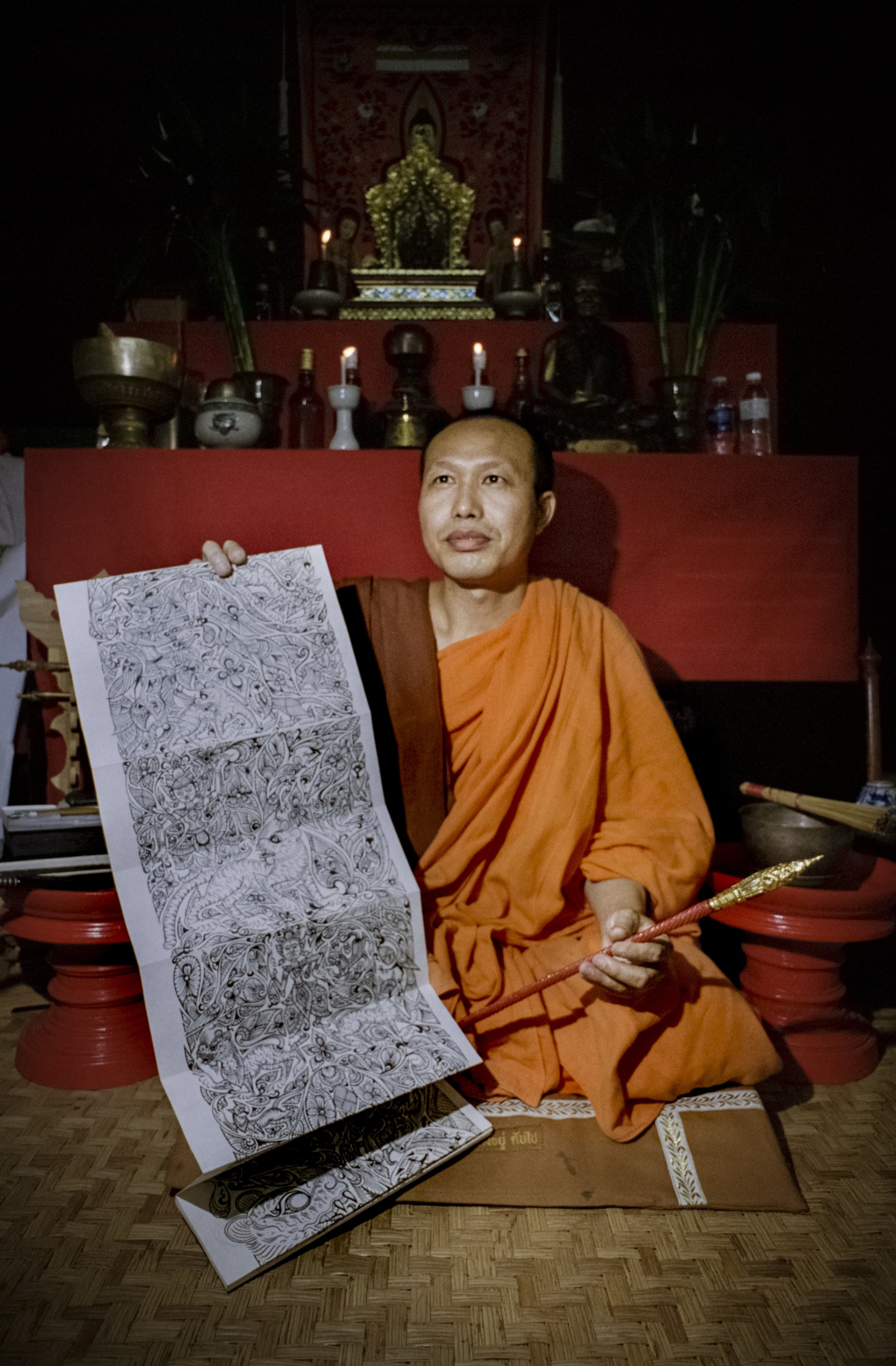
Chiang Mai city, Suan Dok Temple, Thaïland, 2023. Phra Supachai Chayasupho KhiriKhetSuwan, born in 1984 and currently 39, originates from Ban Huai Pong Kan in Mae Hong Son Province, linked to the Shan and Pga K'nyau (Karen) lineages. As both a monk and researcher known as Chao Chang Saeng Khong, he resides at Chiang Mai's Suan Dok Temple. Phra Supachai is skilled in candle making, yantra composition, ancient scripts, and the art of leg tattooing. At 17, he entered monkhood as the primary route to education. In 2008, he formally studied tattooing under Phra Ajarn Phonsit Thammatharo, and in 2009, delved deeper into leg tattooing under Ajarn Lada and Ajarn Sak Kha Lai Pga K'nyau. Starting as an assistant, he learned techniques from Ajarn Lada, later honing his skills and offering Pga K'nyau-inspired tattoos. *This texte was provide by "Tattooing: Body and Social Networking Relations" by Miss Wichitra Jantawong, 2021*
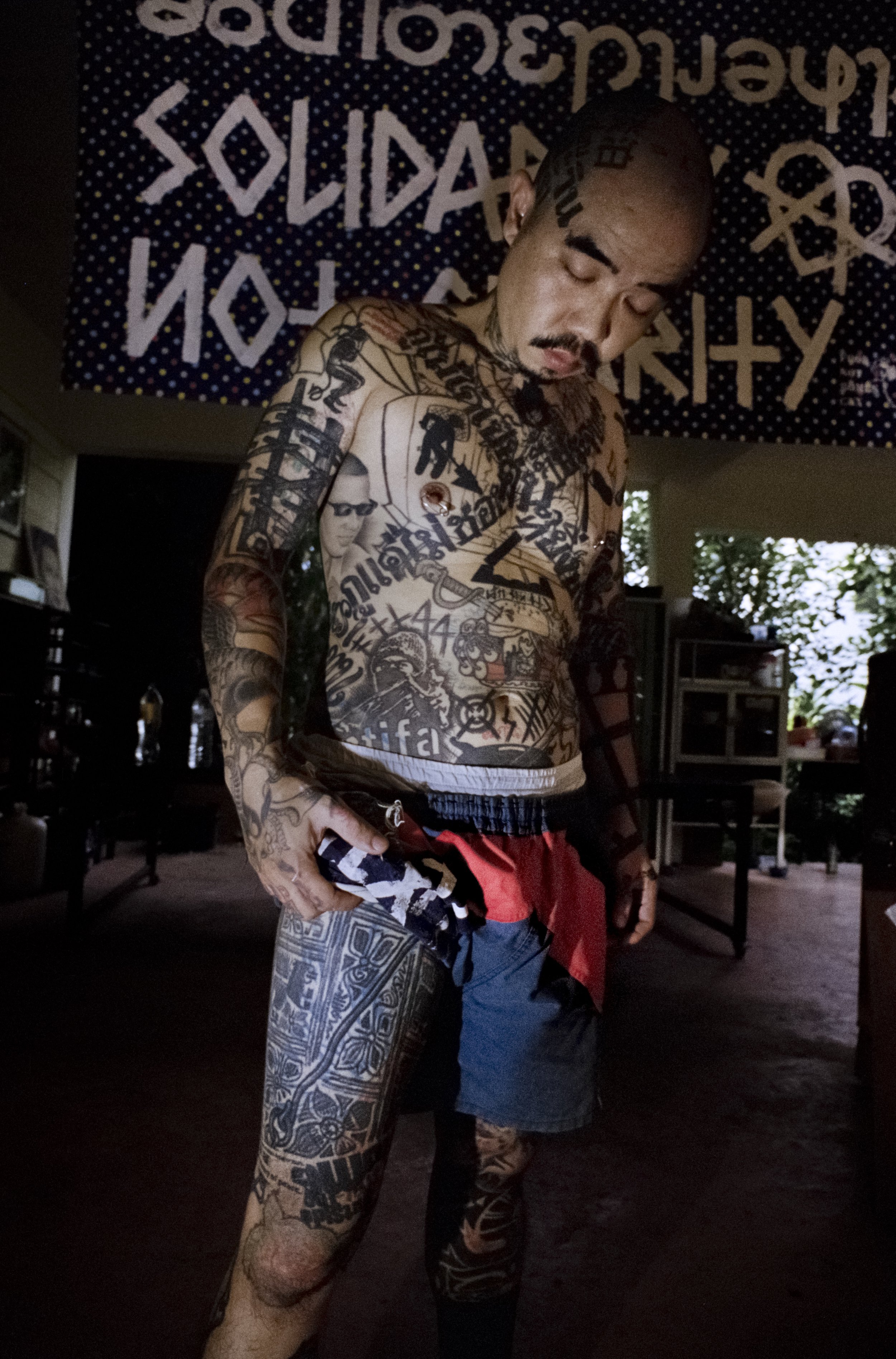
Chiang Mai city, Thaïland, 2023. Maa Moon describes himself as a "tattooist against authority" and is one of the chief organizers of the association Food Not Bombs in Chiang Mai, a global grassroots movement. This organization's primary focus is providing free vegetarian and vegan meals to those in need, utilizing food that would otherwise be discarded. Their emphasis lies in nonviolent direct action and raising awareness about issues such as poverty, homelessness, food waste, and militarism. Through volunteer efforts, they collect surplus food from various sources and distribute it to those hungry or in need, often in public spaces. The movement advocates redirecting resources from military spending towards addressing social issues like hunger and poverty. Recently, Maa Moon faced challenging times and found himself homeless on the streets with his dog. In the picture, he is depicted wearing traditional "Lanna leg tattoos," surrounded by his other tattoos. It's not uncommon for a master to inquire whether you'd like your tattoo to be incorporated into their work or harmoniously blended with other tattoos.

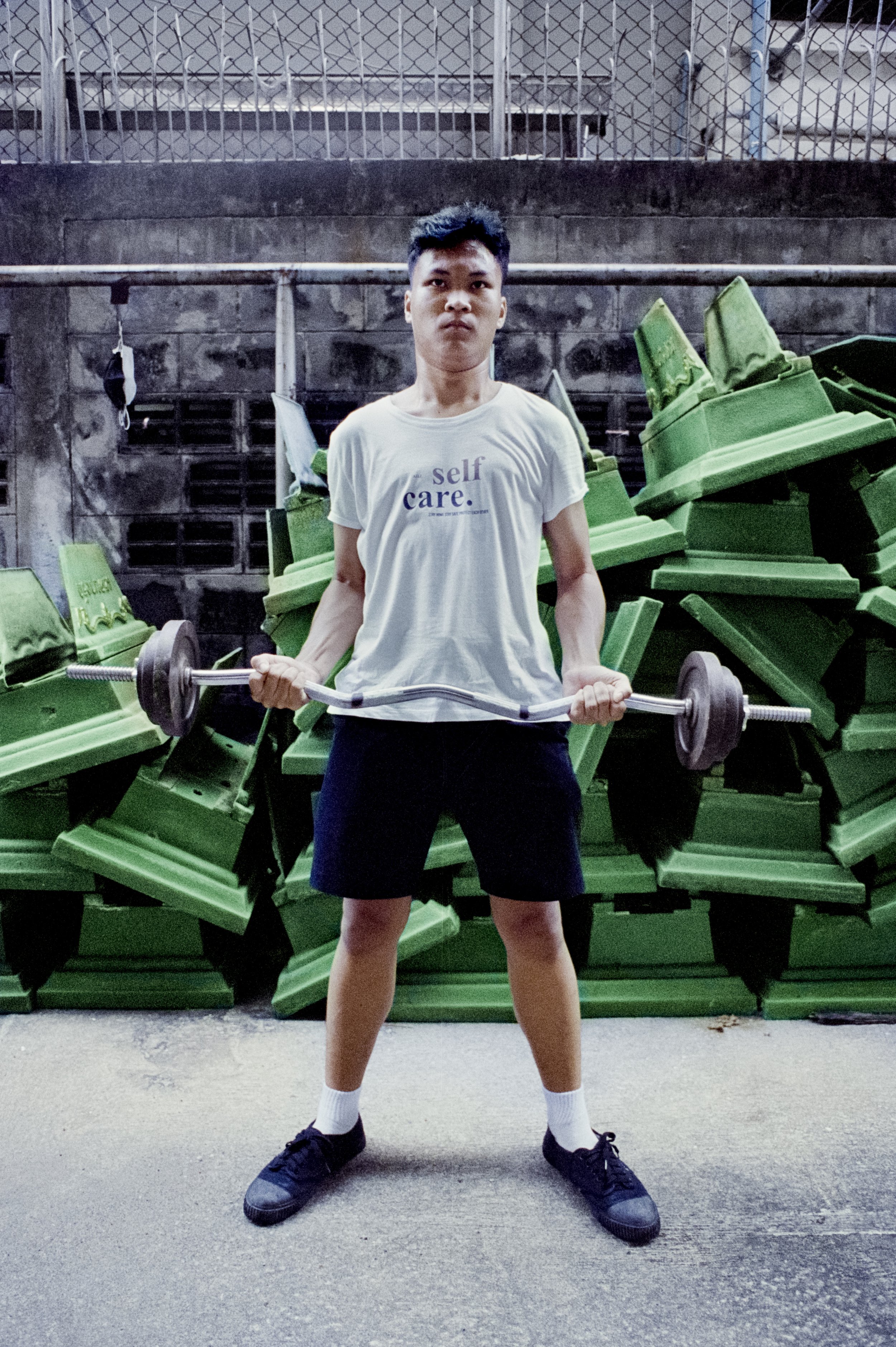
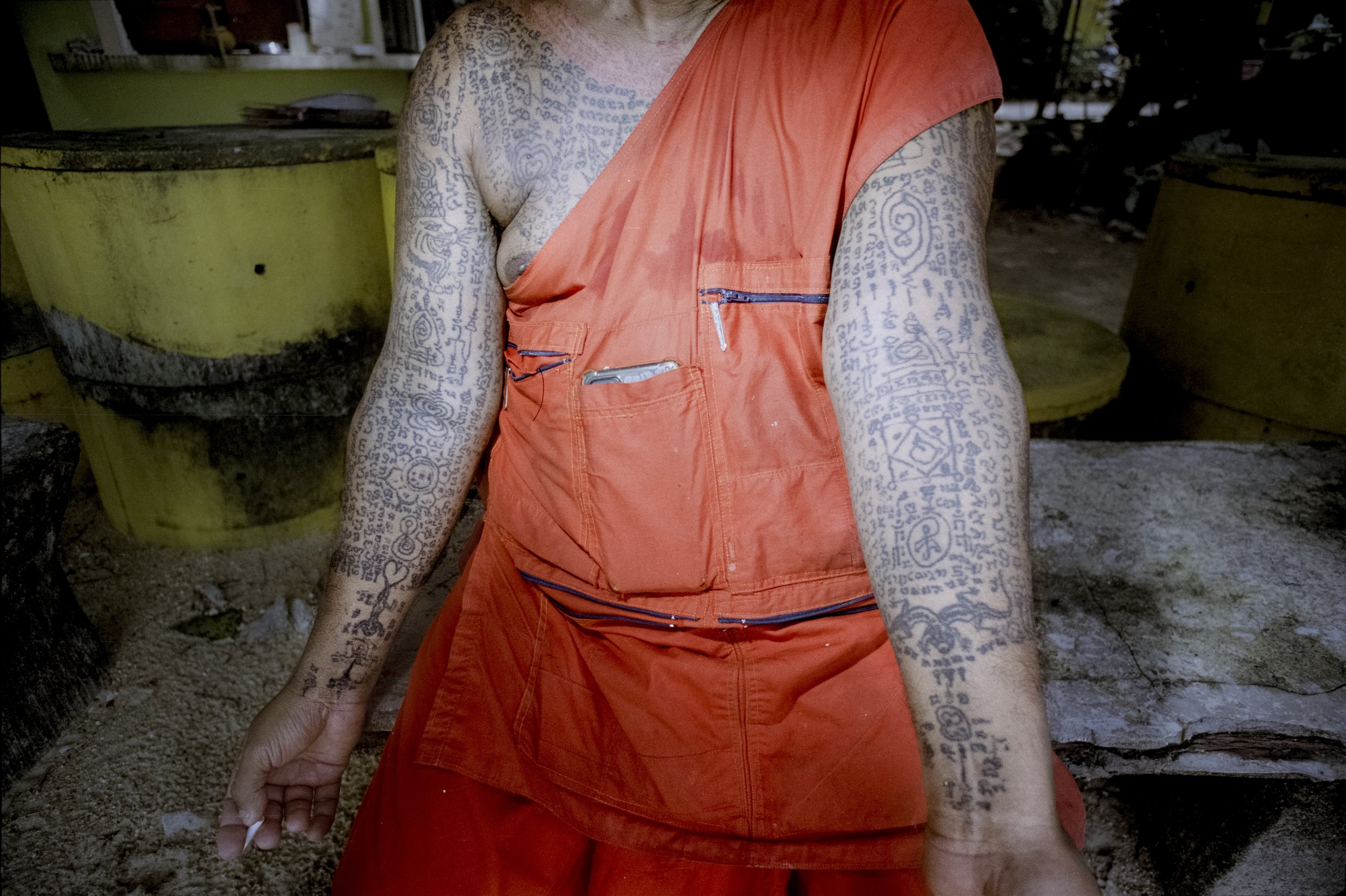

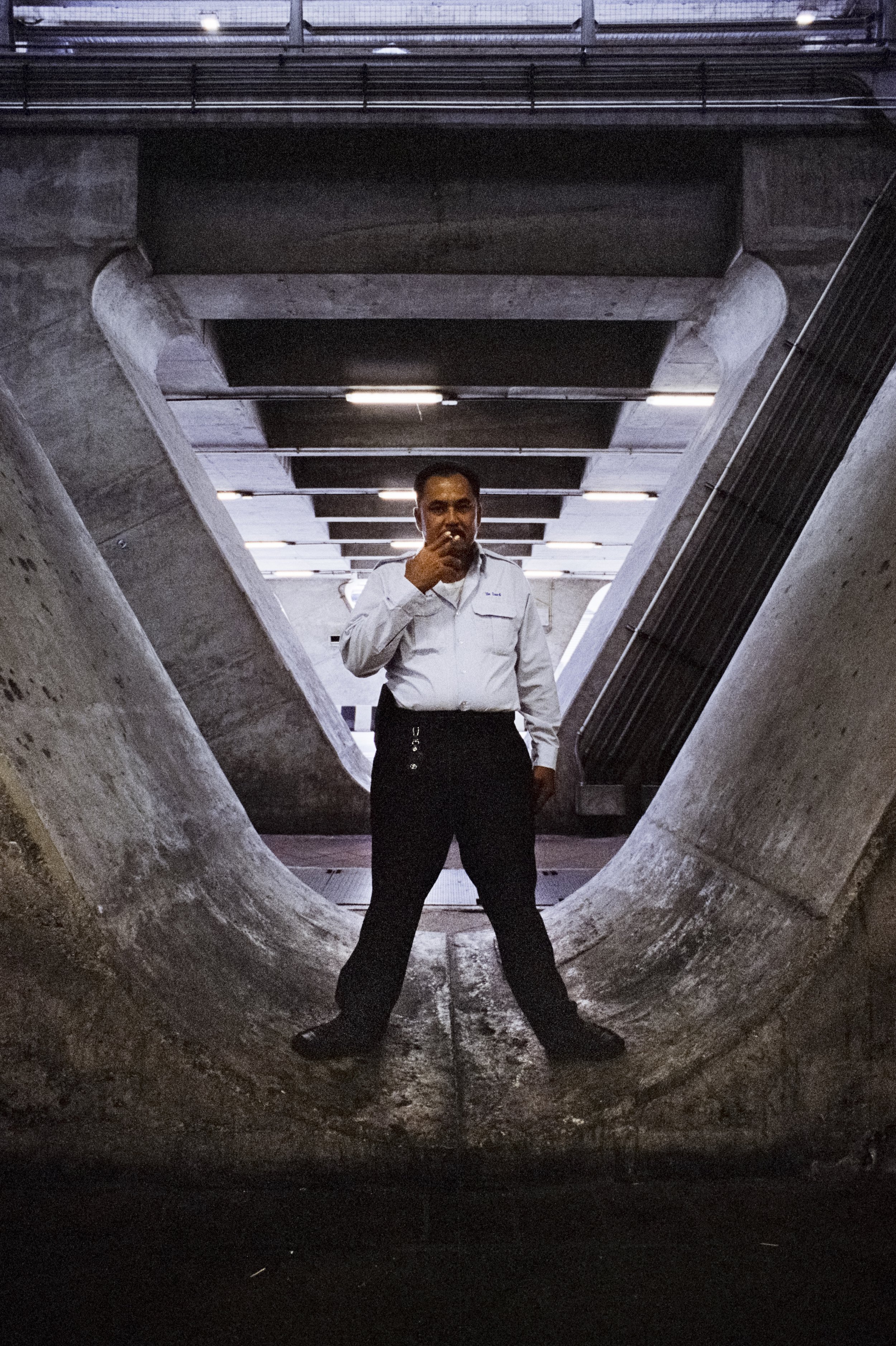
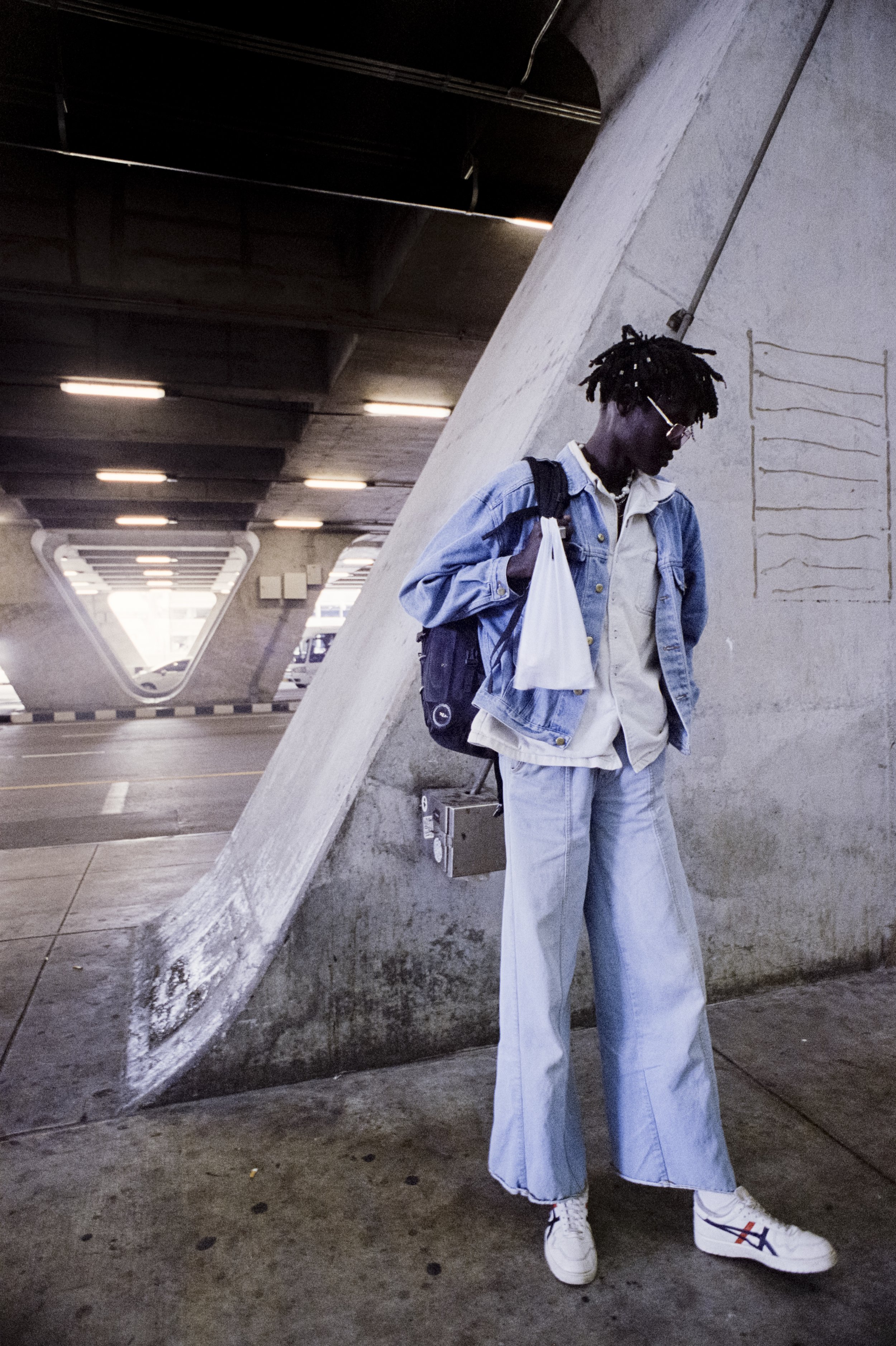
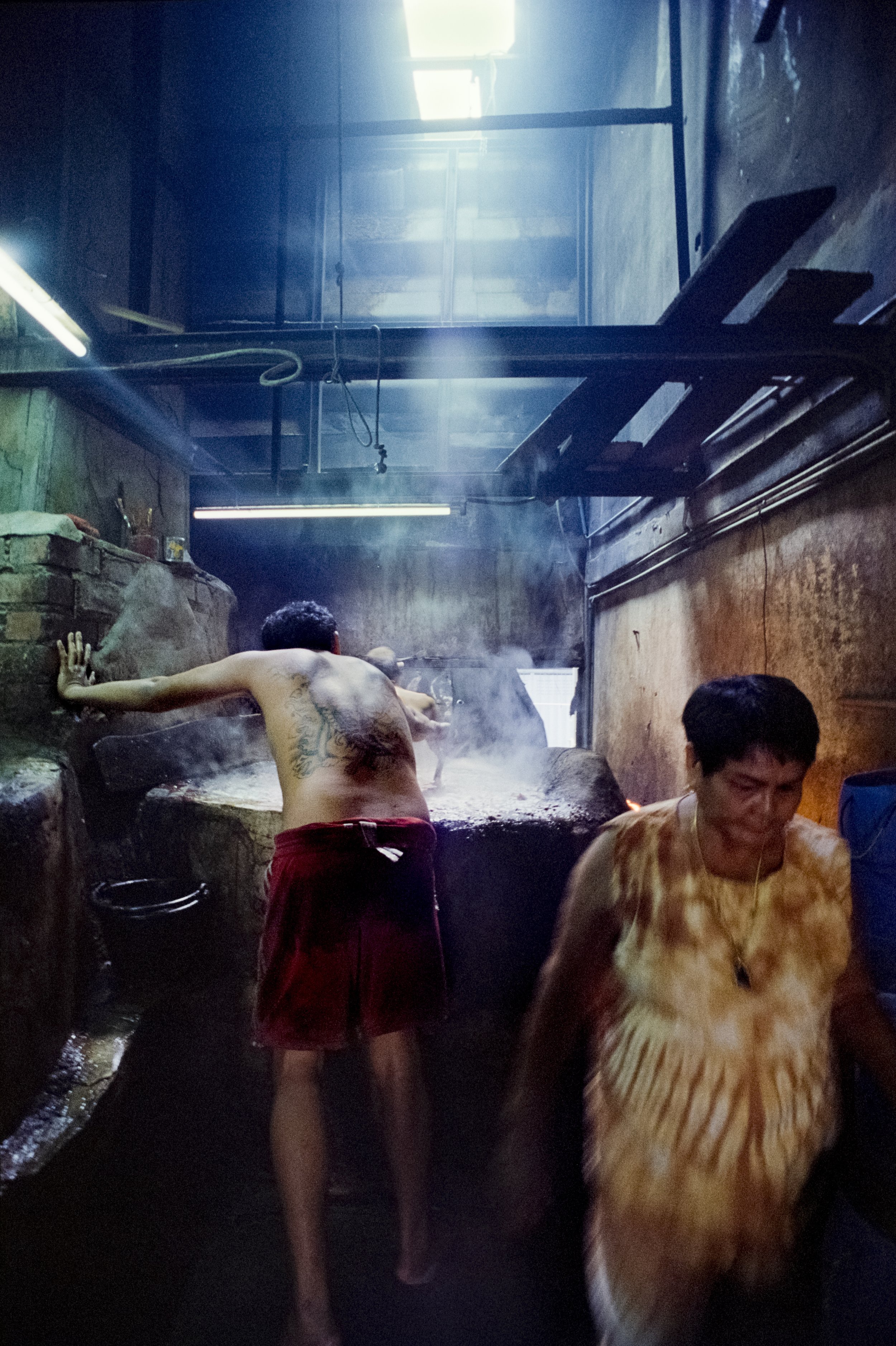
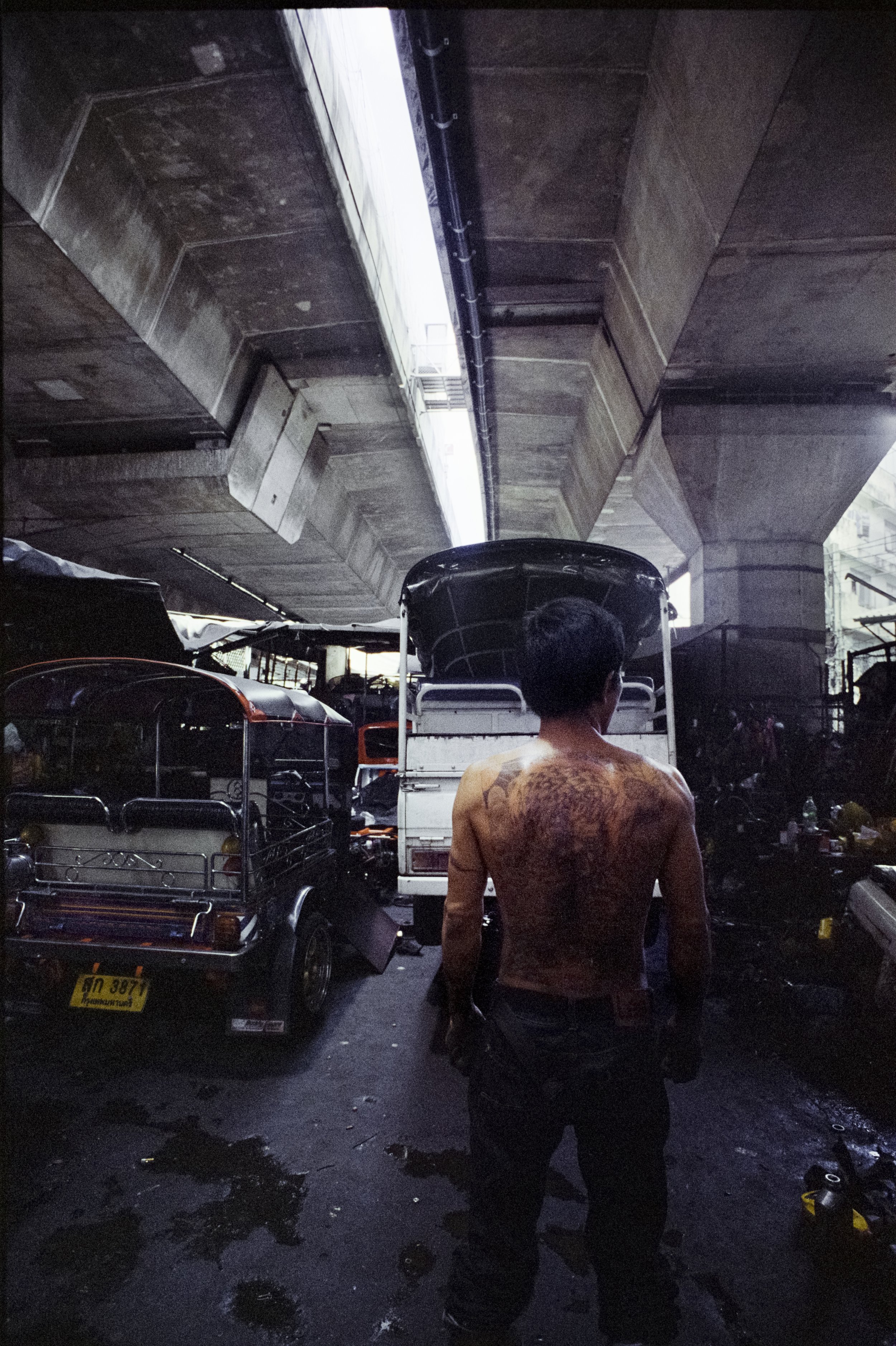


Chiang Mai Region, Thaïland, 2023. An elderly Thai man adorned with traditional Thai tattoos. These symbols depict signs of magical protection. I was intrigued by this group of men walking shirtless. I stopped briefly to get to know them.
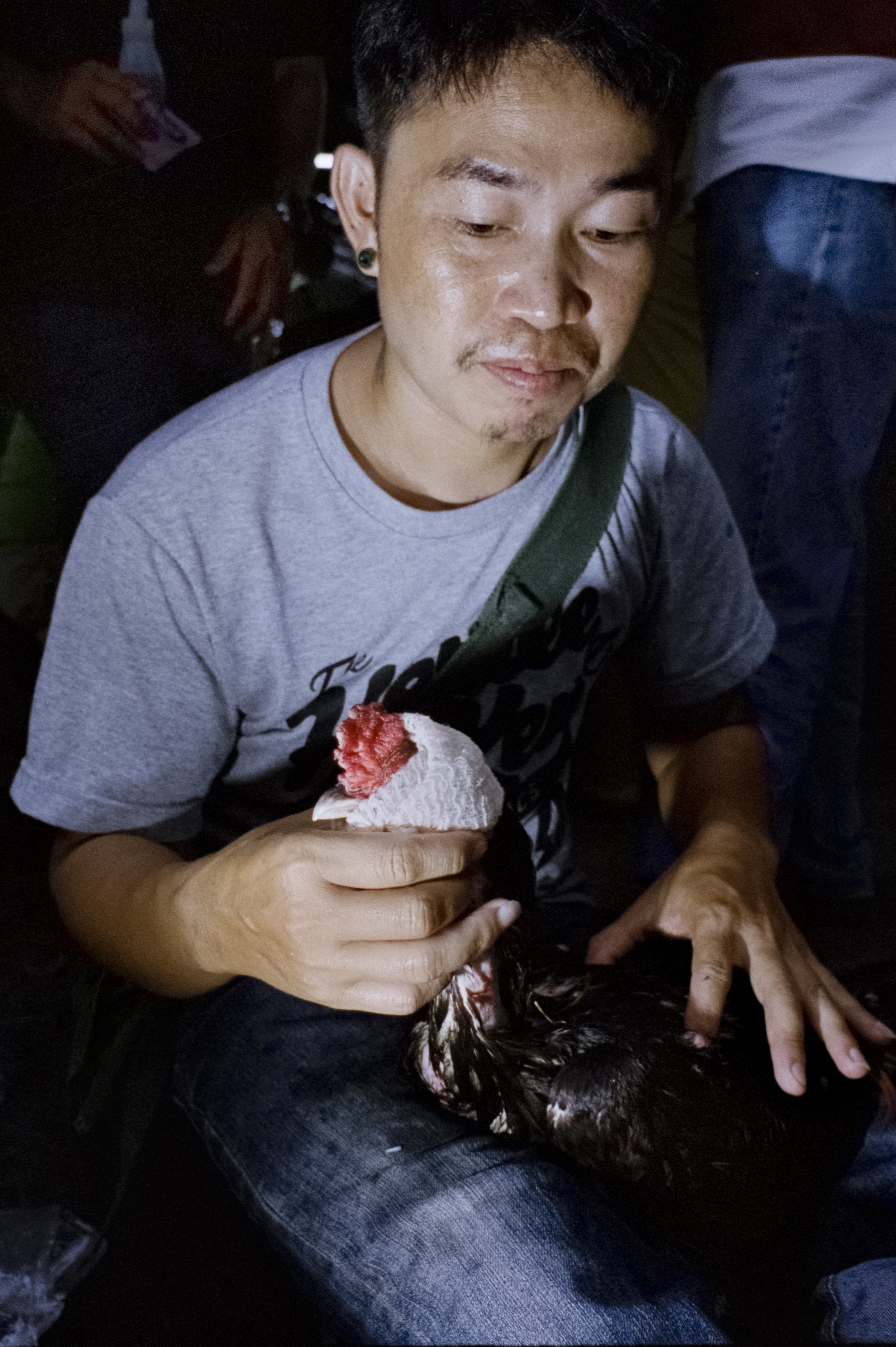
Chiang Mai city, Underground cockfighting event, Thailand, 2023. Cockerels are prepared for fights using various methods. Similar to how Muay Thai fighters wrap their hands, the cockerels' feet are wrapped before they engage in sparring matches with each other. Moreover, they undergo sunbathing sessions to toughen their skin, receive daily doses of vitamins like ginseng and local herbs, regular "showers," and even massages. To clean a cockerel, a method involves holding it between your legs and using a damp cloth that's gently wiped across the body, avoiding the wings. This process covers the head, neck, chest, stomach, back, and feet. For a massage, a warmed cloth is applied to the cockerel's muscles, employing a circular motion to relax the muscles and alleviate any lactic acid buildup. Contrary to common perceptions, cockfighting involves meticulous care for these animals, akin to treating them as precious objects.

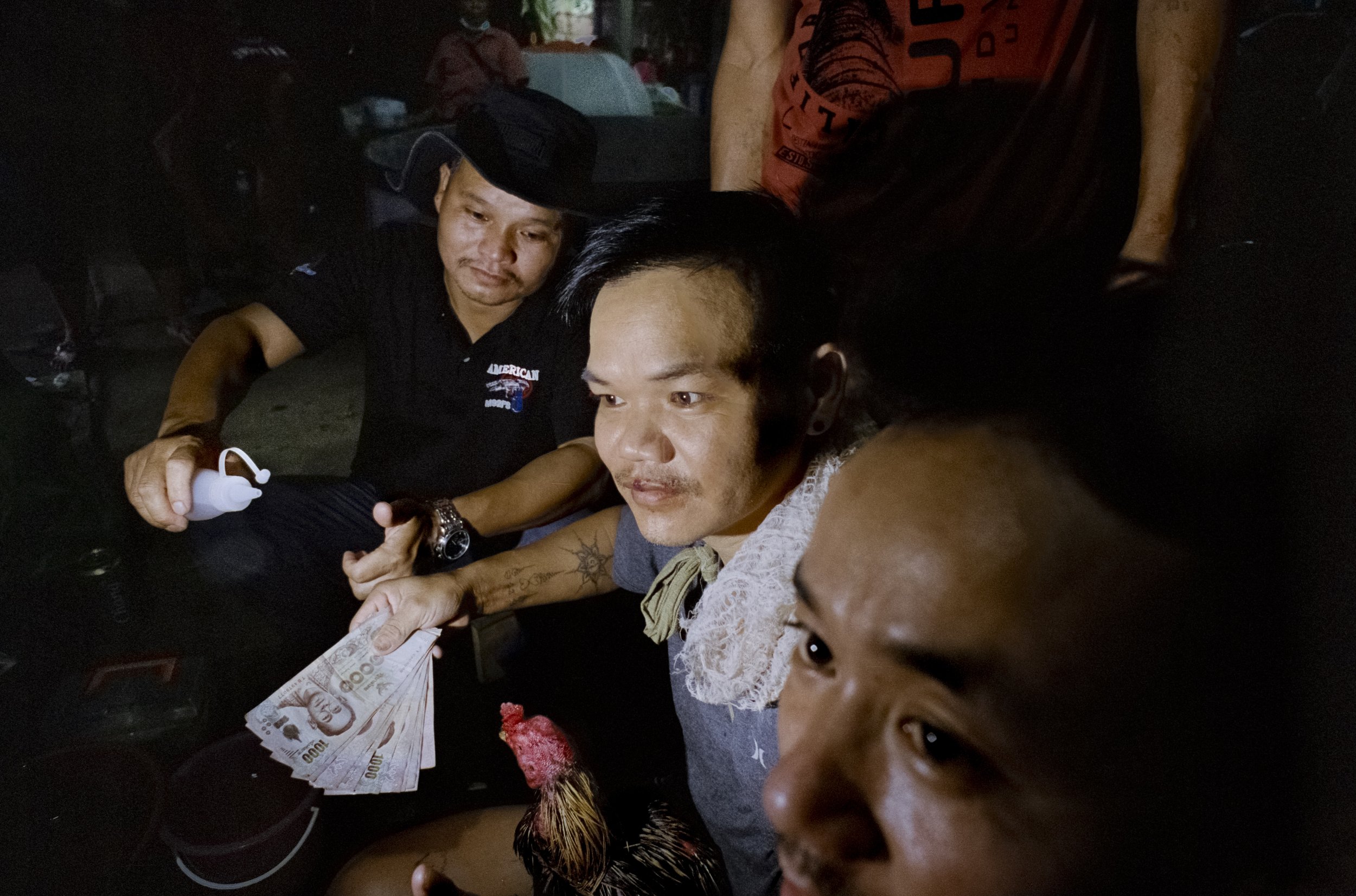
Chiang Mai city, Underground cockfighting event, Thailand, 2023. Despite being illegal in Thailand, cockfighting remains deeply rooted in the culture. Legend has it that Thailand's independence from the Burmese kingdom was influenced by a cockfight between Naresuan and a Burmese prince, an event believed to have saved numerous lives. It's rumored that the mafia uses these fights to solve their problems and save lives. Curious about this tradition, I delved into documenting illegal cockfight events. I was surprised to observe how similar the cockfight was to Muay Thai, possibly explaining the creation of this national sport. Prices can reach several thousand dollars. The chicken in this picture was valued at $500 for 5 rounds of 20 minutes.
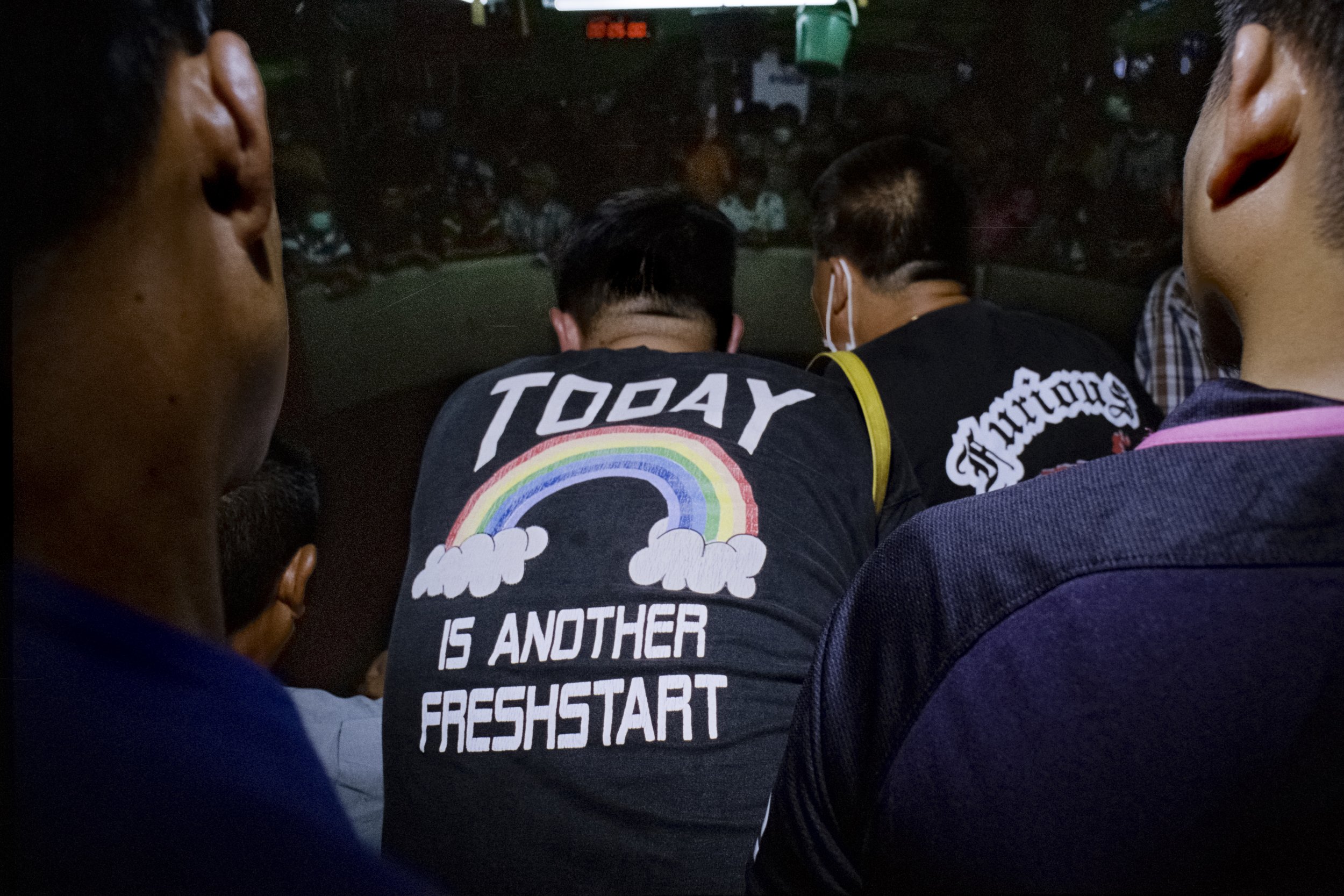
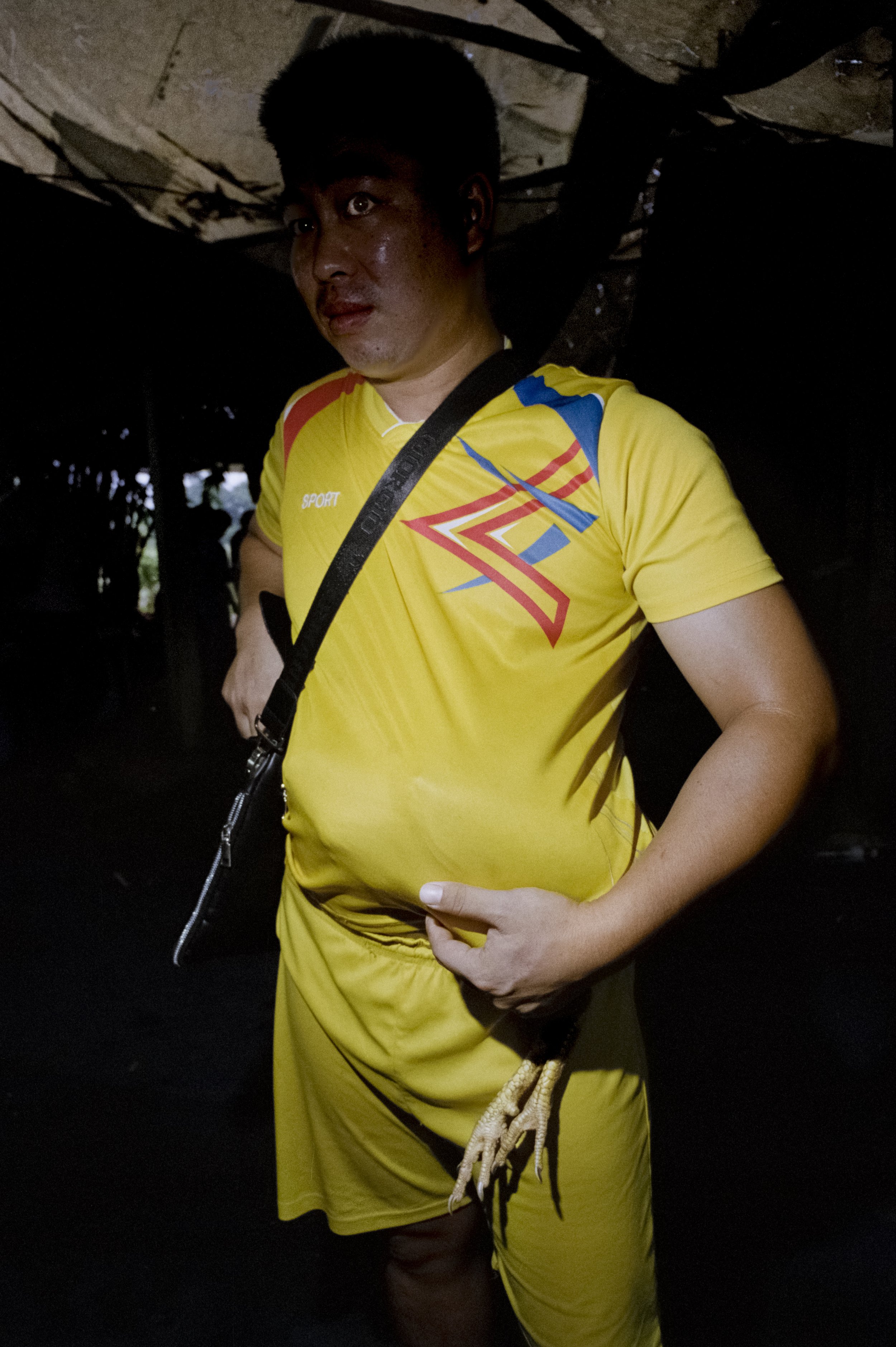


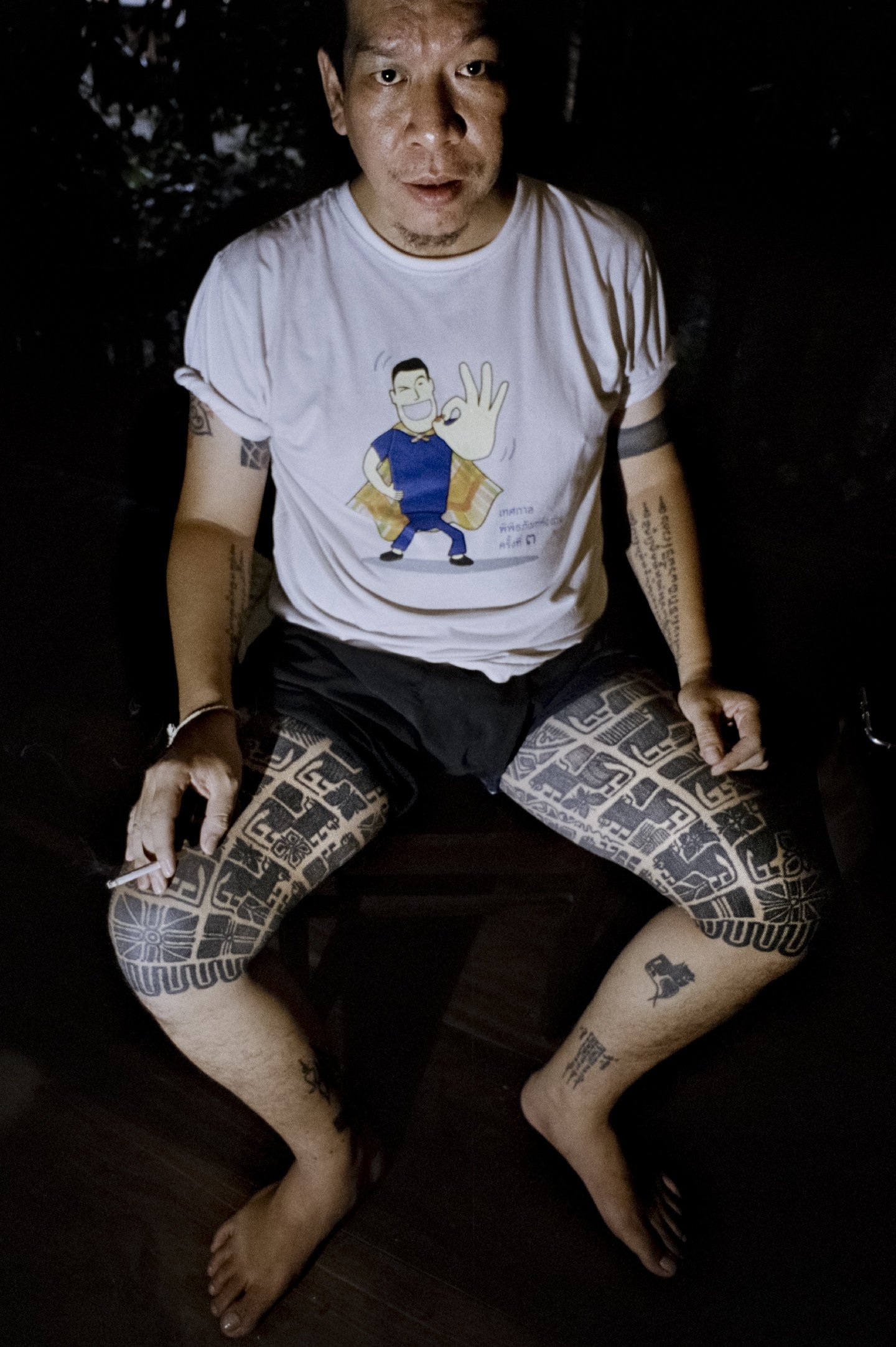
Chiang Mai city, L’école française d’extrême-orient à Chiang Mai, Thaïland, 2023. Phongsathorn Buakhampan, also known as Dr. Gun, serves as a research assistant at the École française d’Extrême-Orient in Chiang Mai. He essentially acts as the last archivist and anthropologist of this community. Winnie, a dear Thai friend who served as my translator and connection to these individuals, insisted on introducing me to Dr. Gun before proceeding further. Dr. Gun quickly recognized my genuine interest in learning about the Karen community, especially the 'Lanna leg tattoo tradition,' and acknowledged my commitment and trustworthiness as a foreigner with strong work ethics. Our friendship developed swiftly, and I extensively studied with him to understand the principles and methods underlying their practices. He played a crucial role in facilitating my welcome and documentation of the Tapijo village, home to Ajarn Lada's community.
Artist intention
Coming from a background in street photography, it has allowed me to spend a significant amount of time with individuals whose lives might have remained hidden from our conventional media. Photography has always served as a means for me to intertwine my interest in people's behavior, backgrounds, and the representation of a reality that often goes unnoticed.
Before coming to Thailand, a friend who has been working there for four years now invited me to document the rich traditional heritage of the country. She had spent time in the past with important members of the Karen ethnic group while working on a documentary. She insisted that I would find in Thailand a profound and interesting subject to cover. I didn't have a precise vision of what to document overall, but I knew that I would find a direction while being there.
Personally, I have a particular interest in tattoos because I believe they always reveal a part of a person's unknown background, tradition, and more. They are pure identity marks on a human body. While searching for ideas to explore, it became clear to me that I had to document traditional Thai tattoos, specifically the sak yant, and visit ethnic communities to learn about Thailand's history, beliefs, and cultural heritage. I didn't see an immediate connection between these subjects, but it was interesting enough to me that I told myself I would give it a try to have a good overall picture of what is going on there.
While spending time with the Karen people, I discovered the significance of this ethnic group. These people, whose lifestyle is almost entirely off the grid and similar to how they lived hundreds of years ago, are the ones actively protecting the land of a country that is disputed due to economic interests. They tried to show me how they were connected with nature and how they are self-sufficient compared to modern society. After spending a significant amount of time with them, I returned to the city to cover traditional Thai tattoos. I decided to stick to my plan. I quickly realized the contrast between the lifestyle and traditions of Thai people and the Karen ethnic group. They still shared similarities: both are strong believers and have rich cultural heritages.
While documenting the traditional Sak Yant tattoo, I aimed to showcase how an ancient tradition adapts to modern society. I wanted to provide an authentic depiction of how a traditional tattoo session unfolds. As I spent more time in Chiang Mai, the place where I was primarily based, I gradually became acquainted with tattoo artists.
During this time, a fellow artist friend mentioned the need to document the 'Lanna Leg Tattoo' in a traditional Karen village. When I saw the images and learned more about it, I felt a deep connection between this new subject and what I had previously covered. It appeared to be the perfect link between tradition, ethnic groups, and tattoo art.
While navigating my way to meet everyone still involved with this tradition, I began to grasp the profound importance of the work I was undertaking.
I was accepted into this 'family' and learned from them the essence of this tradition. Initially, there was a lot of reluctance, with some thinking I might take advantage of them or that I didn't truly belong. However, the moment I showed them my commitment by getting a traditional tattoo on myself with their permission, they realized I wasn't just there to take pictures but to genuinely immerse myself and understand their culture.
I felt that every picture I took could very well be the last, considering there was only one Karen tattoo master in the world practicing this style. These photographs serve as authentic archives of a tradition that is on its last legs. My intention was not only to document the last master and his village but also nearly everyone involved in this tradition. I aimed to provide an objective and intimate portrayal of each person who bore these tattoos on their legs, each with their unique reality in modern society. What does it mean to carry this with you? Why did you do it? What was it like when you did it? These were all aspects I sought to represent.
This project offers a unique opportunity to immerse ourselves in a culture that is not widely known or understood. We all believe in the importance of preserving culture, and in this case, where concrete actions to help may be limited, I believe that learning from these archives, simply remembering those who carried these traditions and cultures, and raising awareness is the most impactful contribution we can make. The power of not forgetting should never be underestimated.
"© [RAOUL FORTIER-MERCIER] [2023]. All rights reserved. The content within this project, unless otherwise specified, is the intellectual property of [RAOUL F. MERCIER]. Any unauthorized reproduction, redistribution, or modification of this project without express written permission is strictly prohibited."
